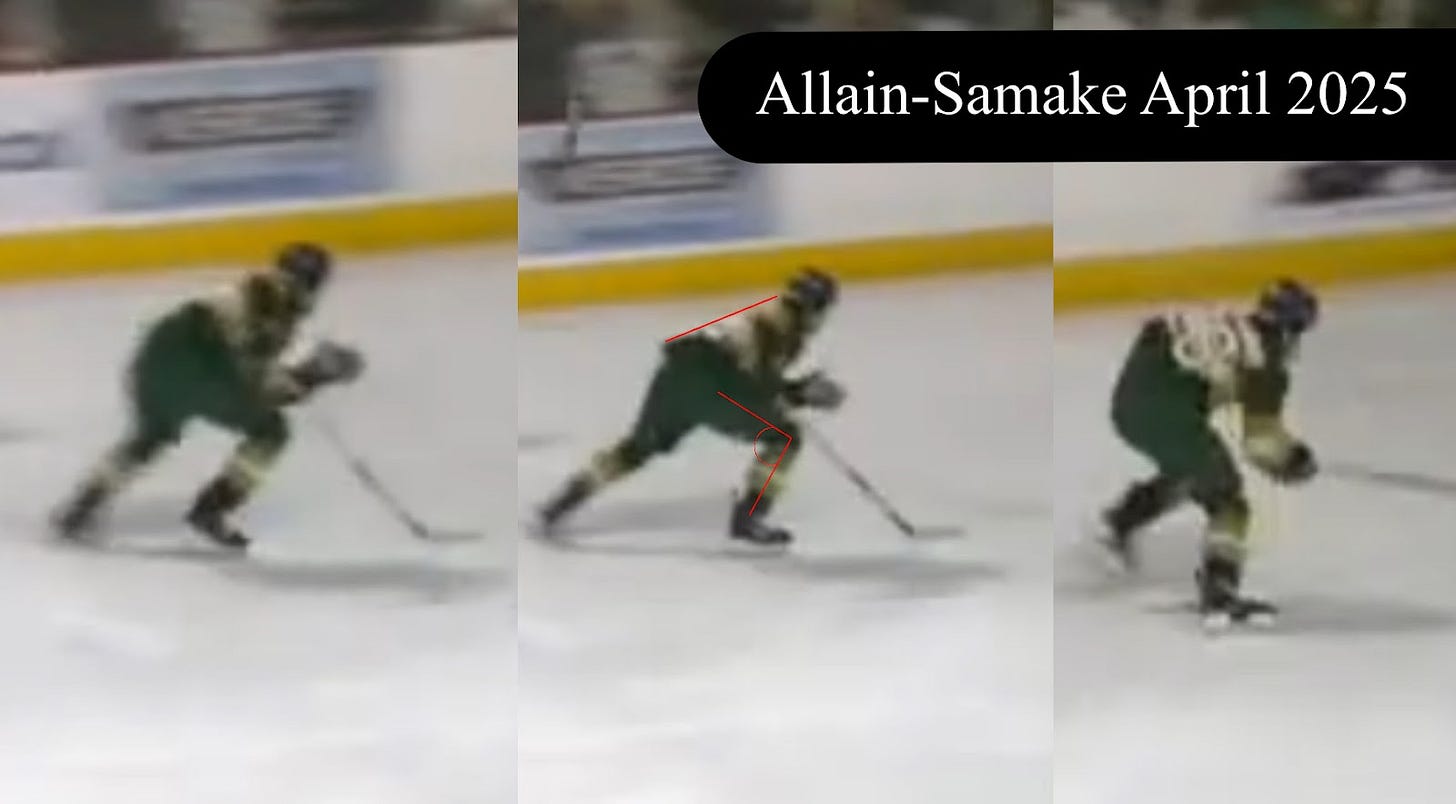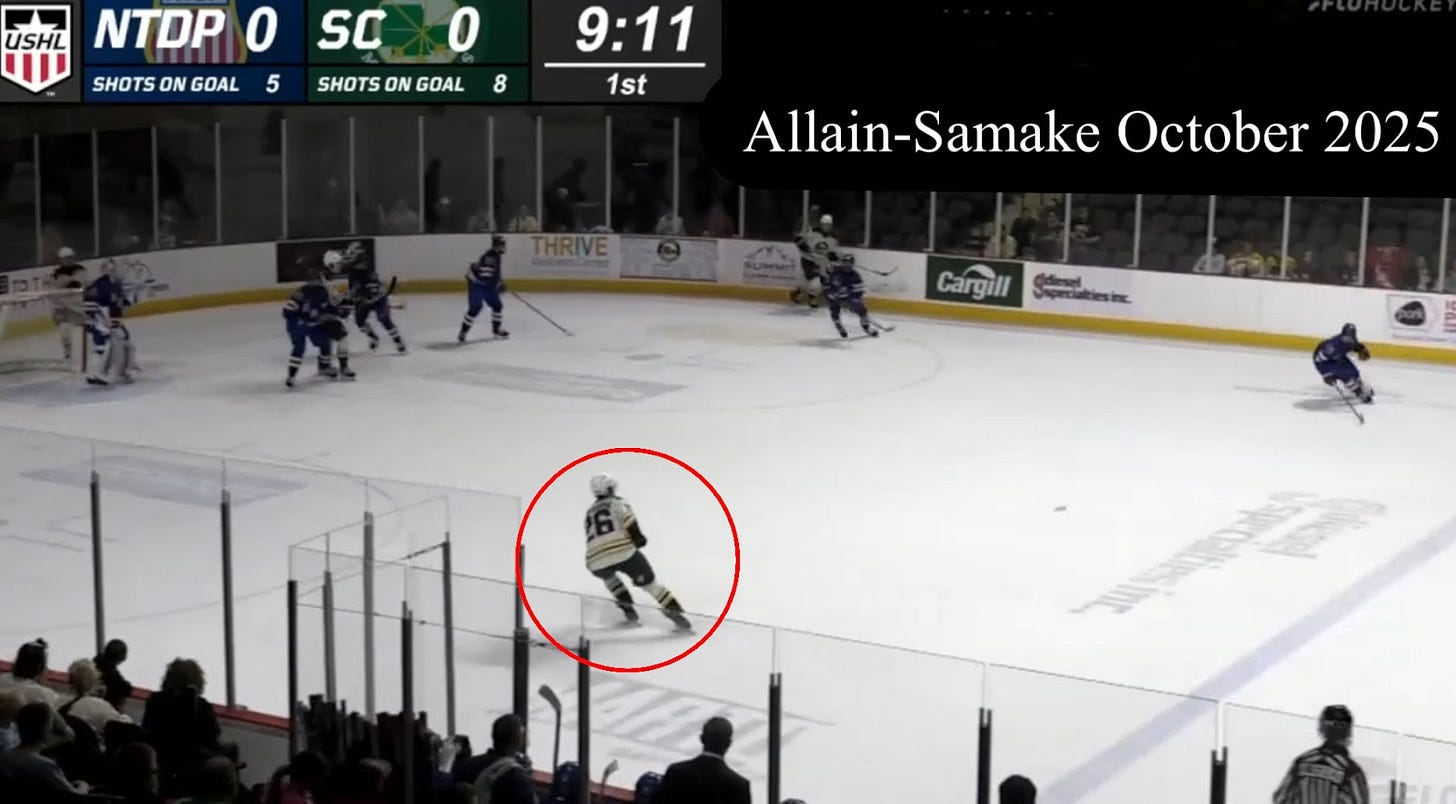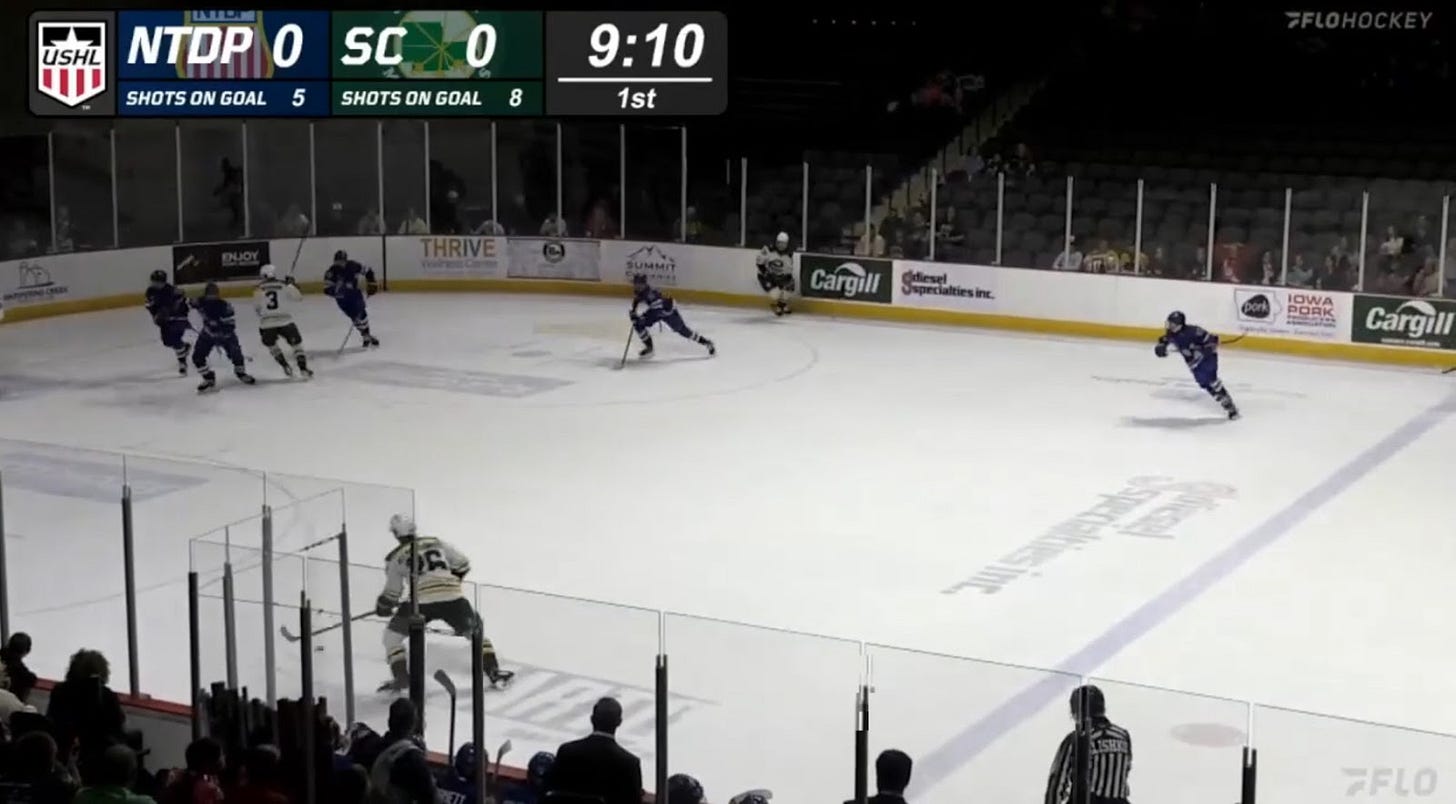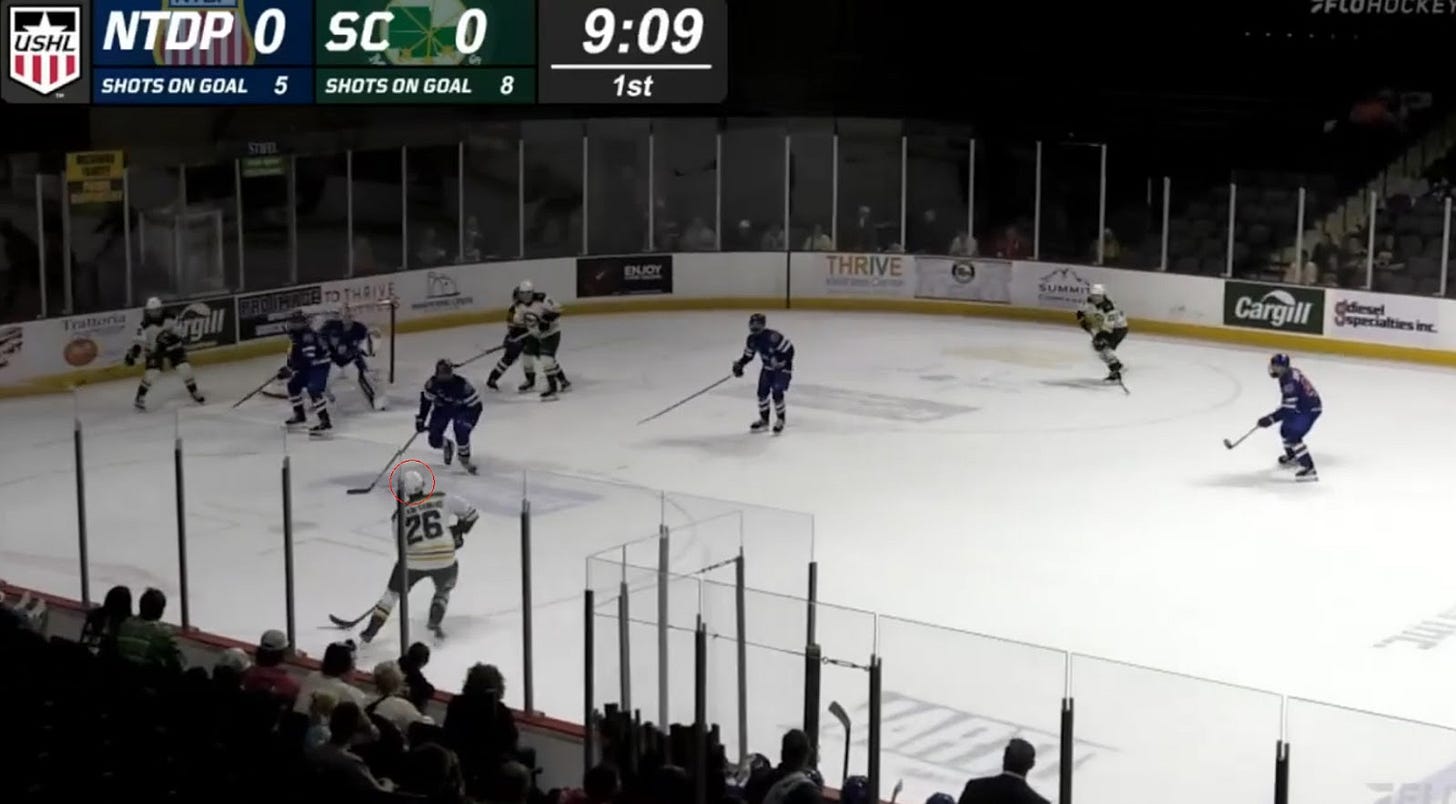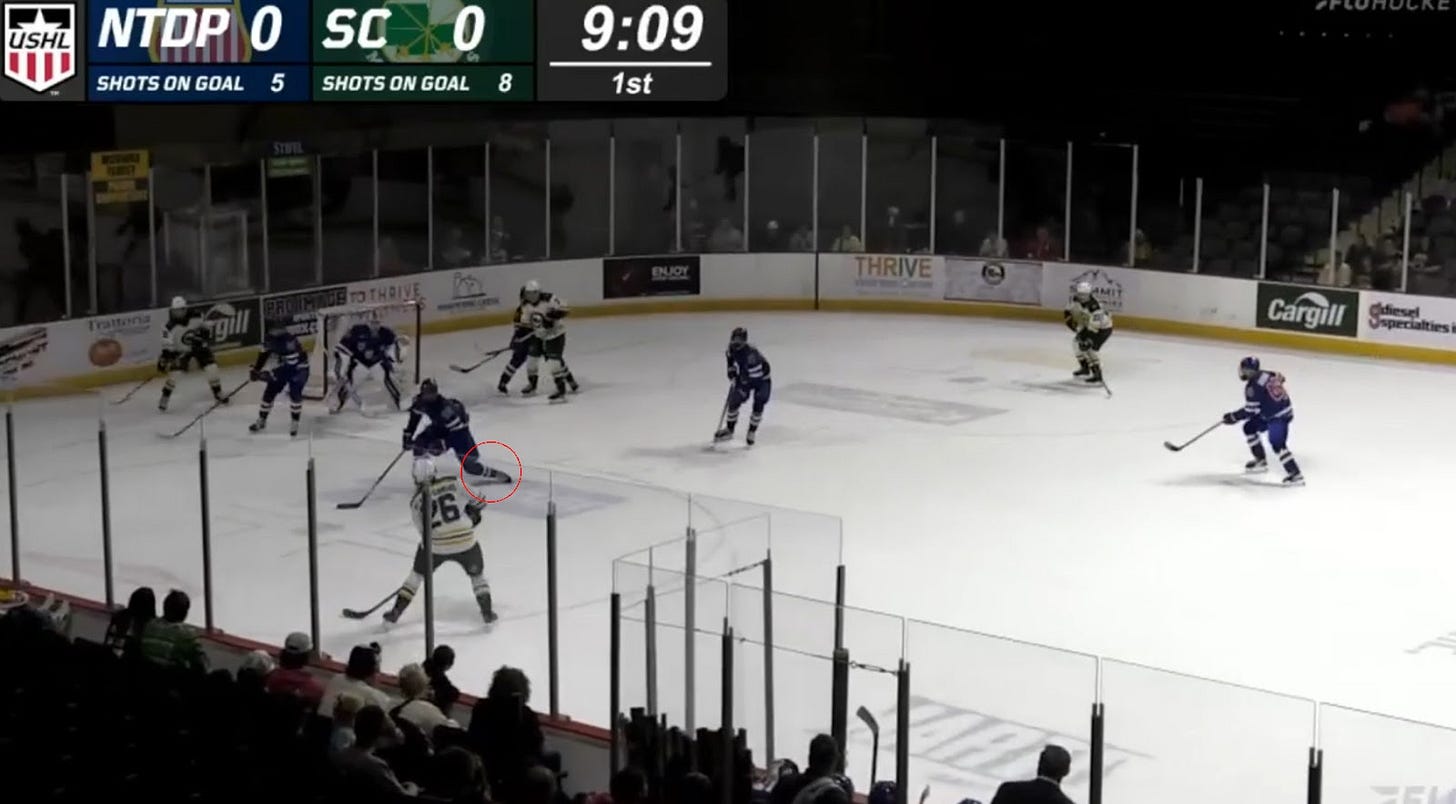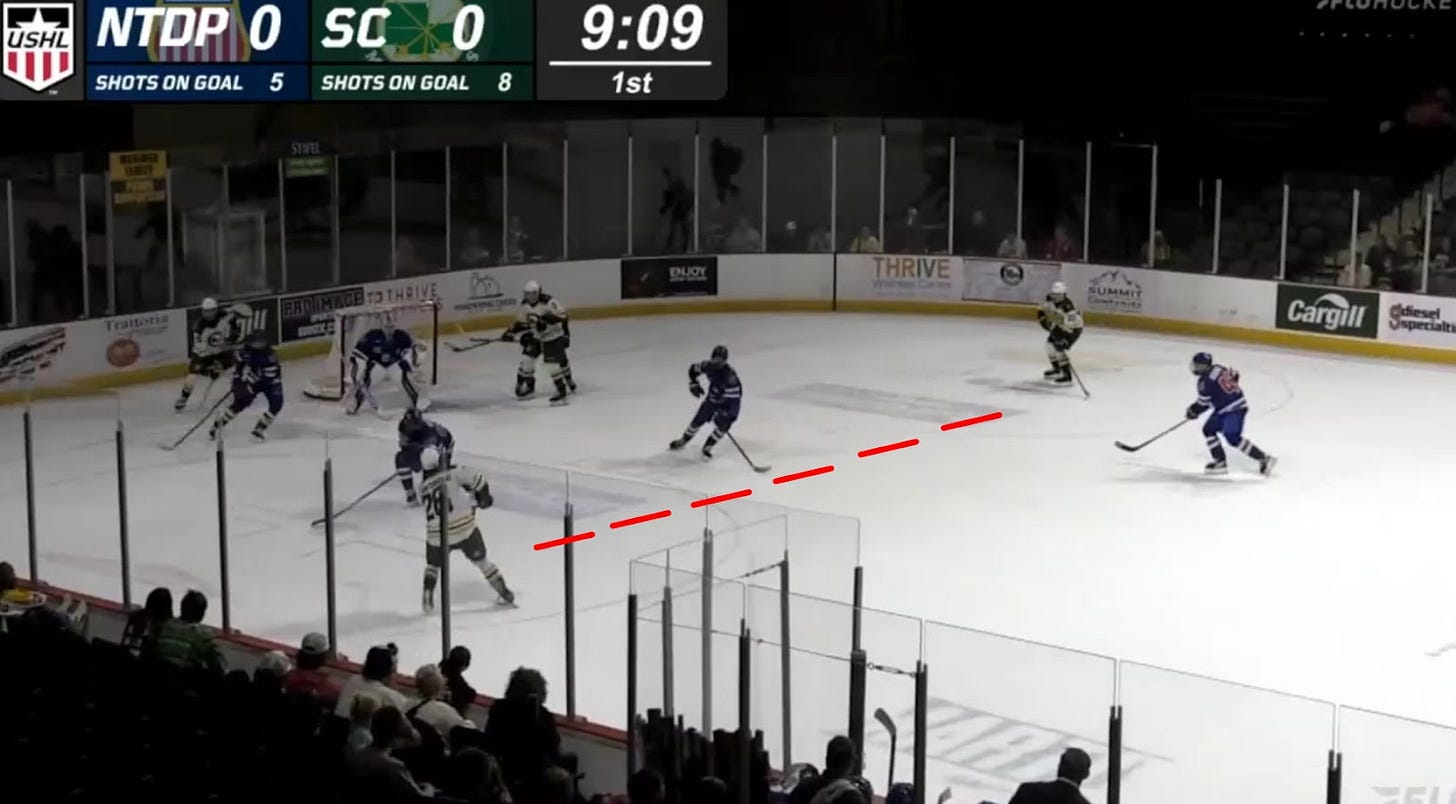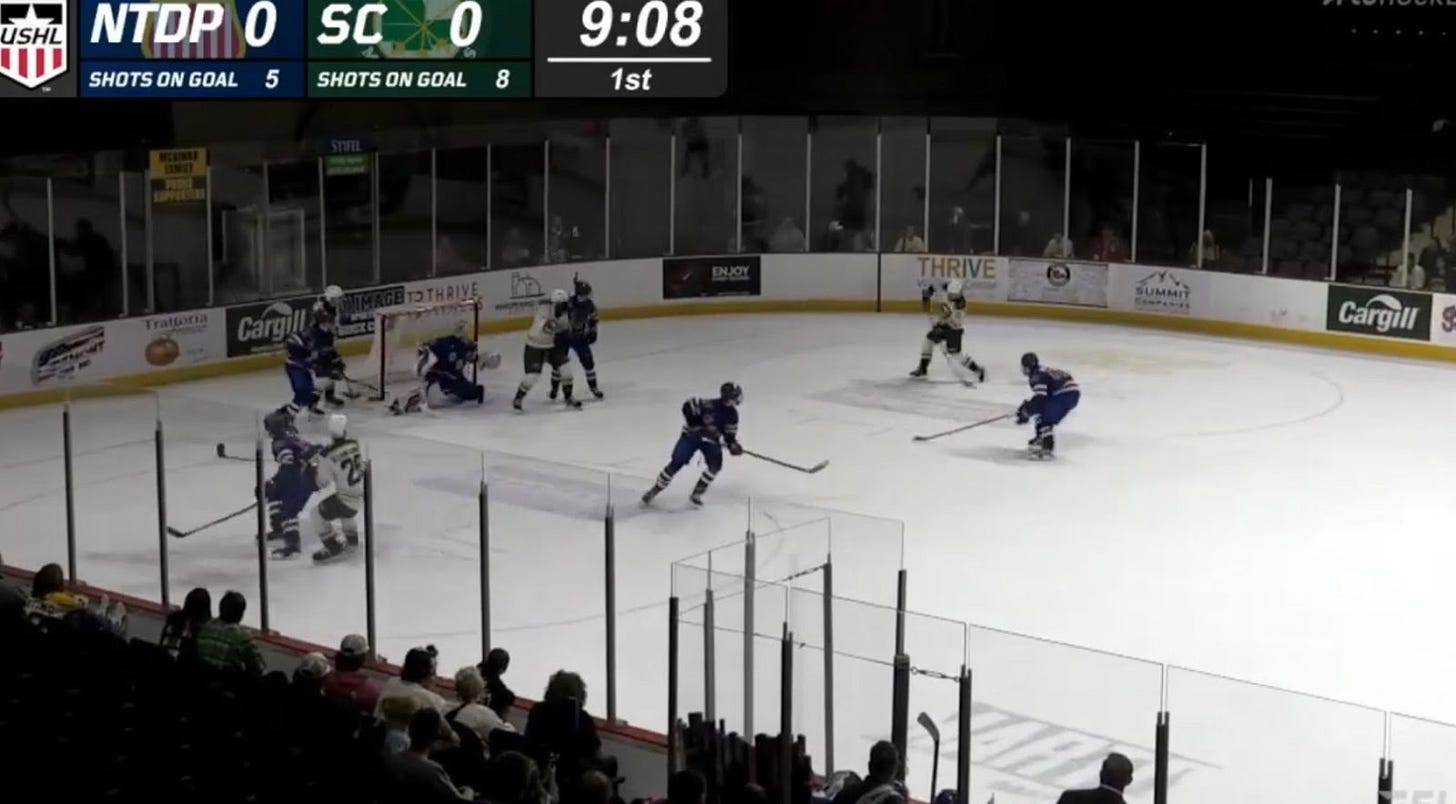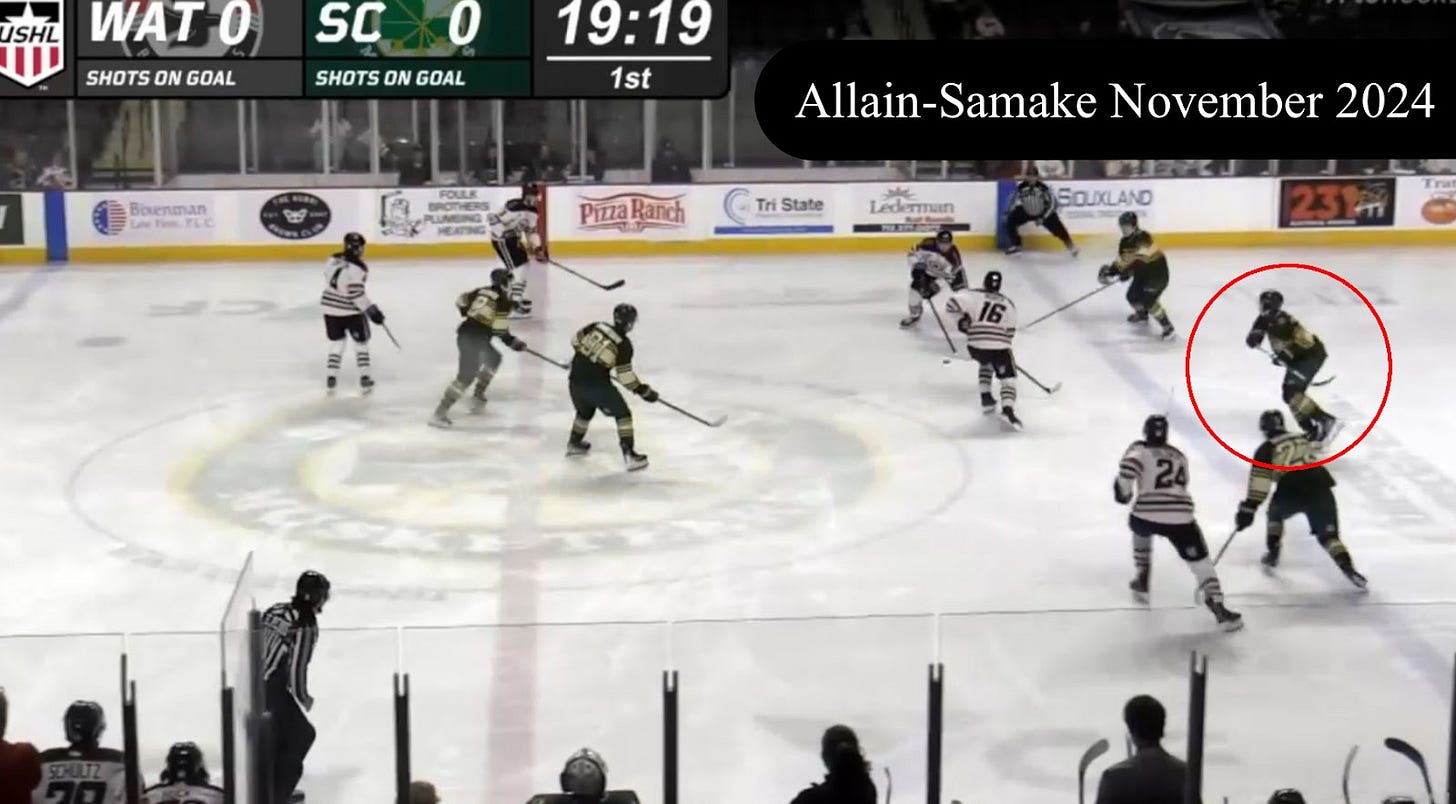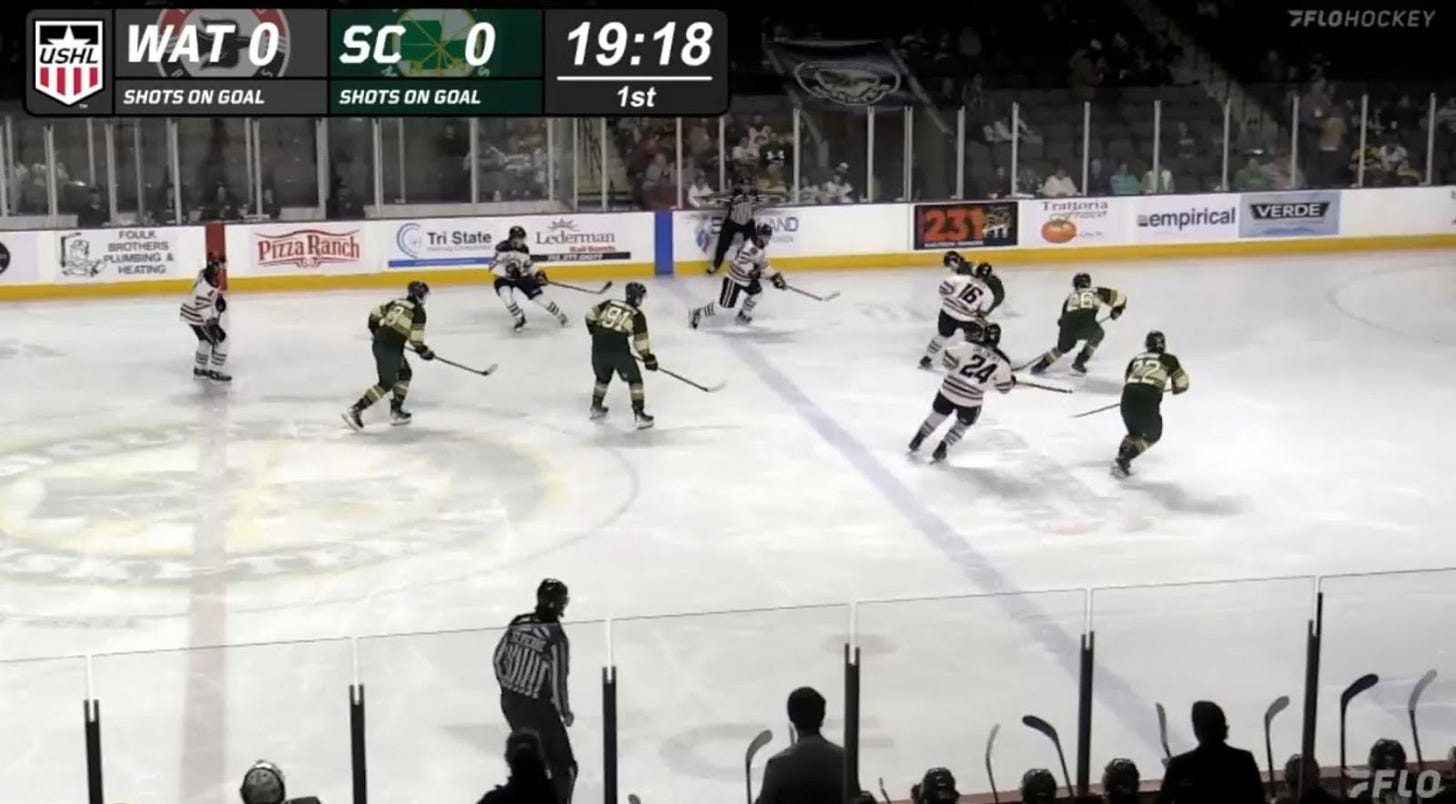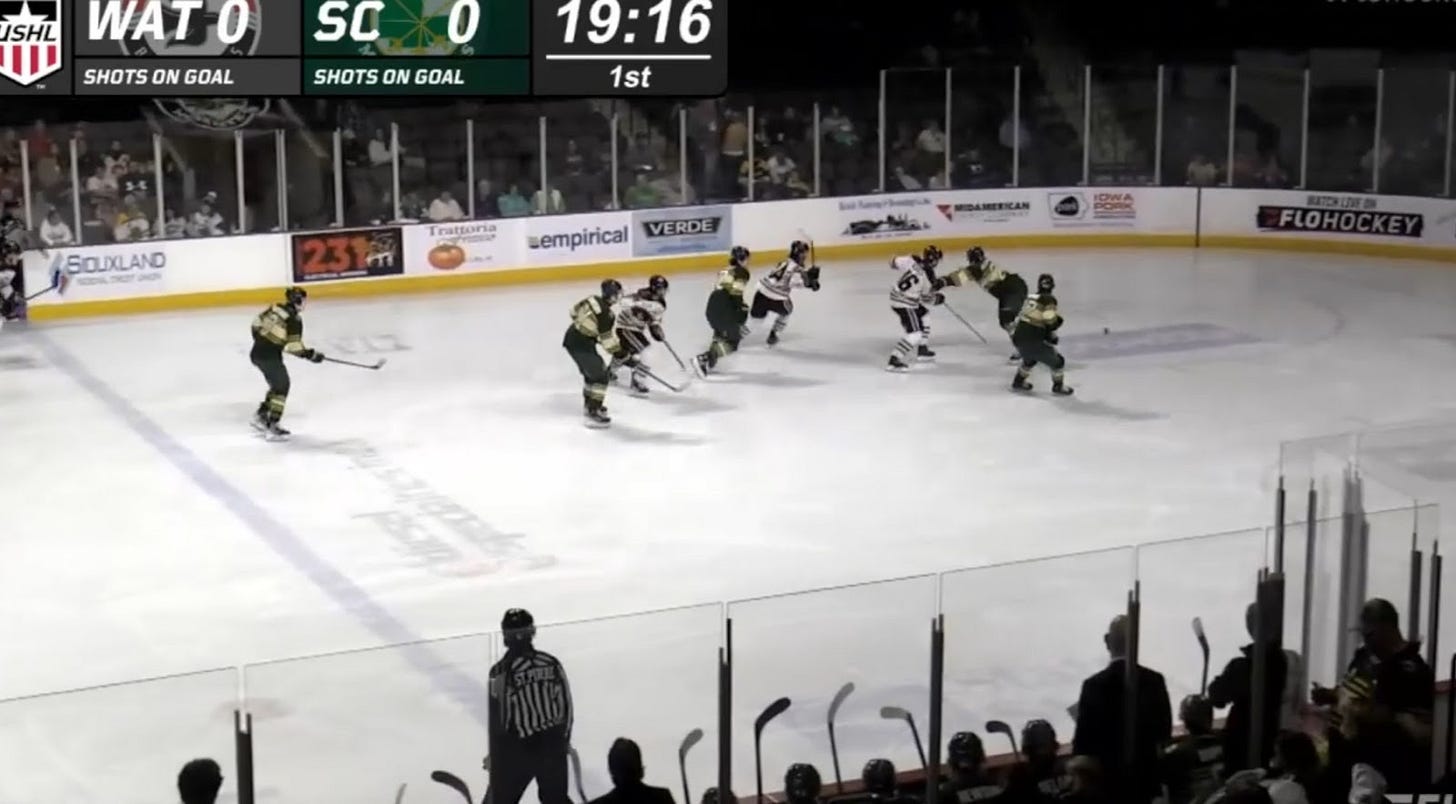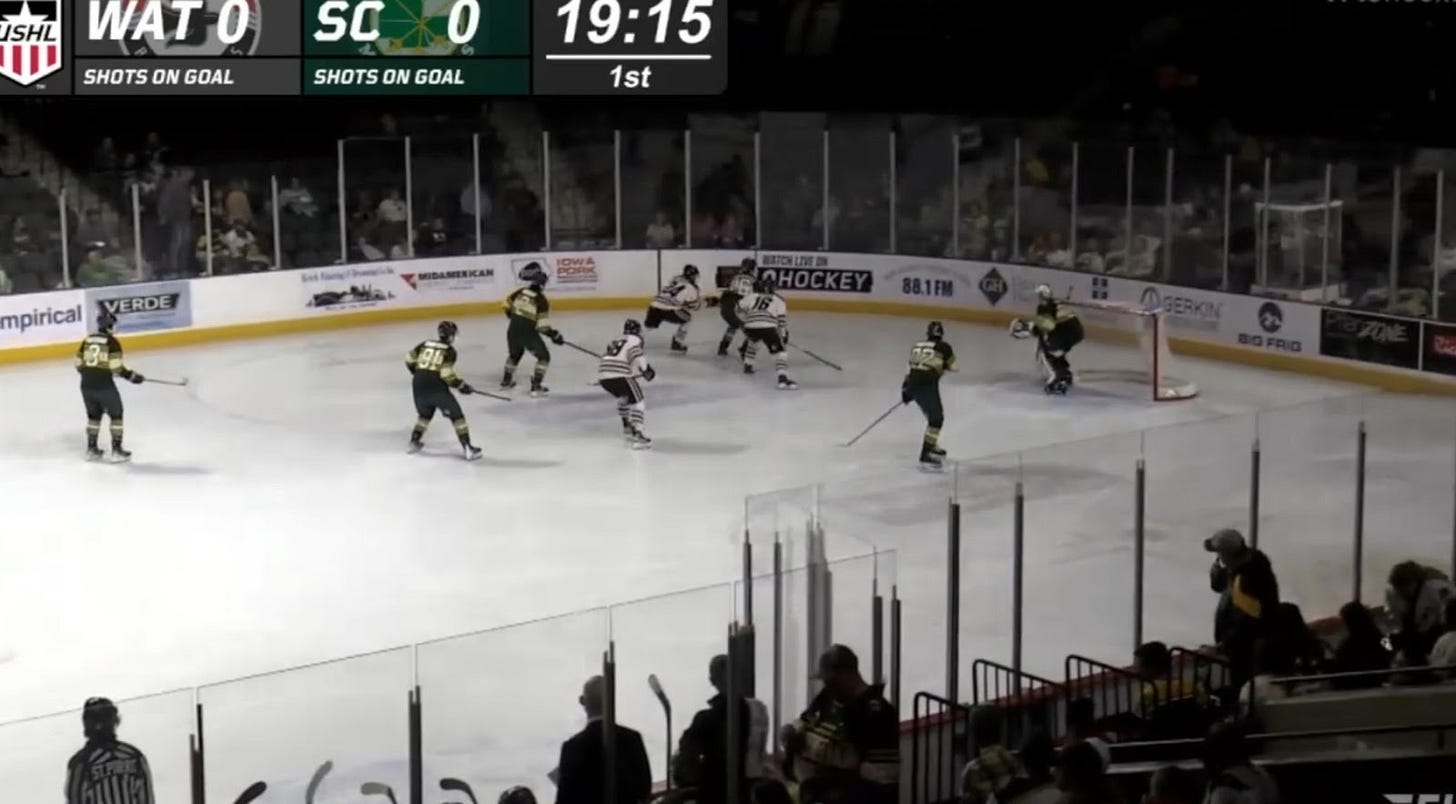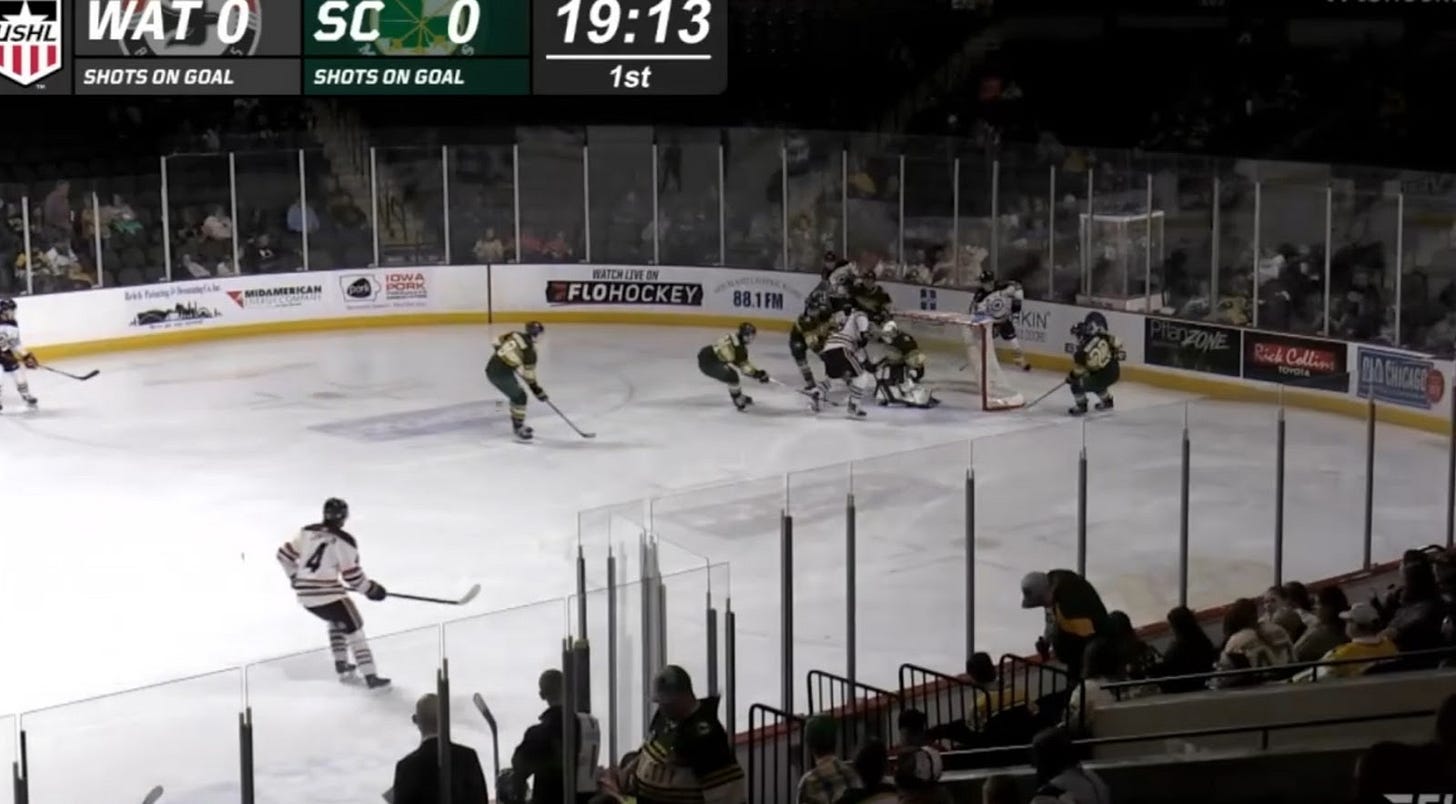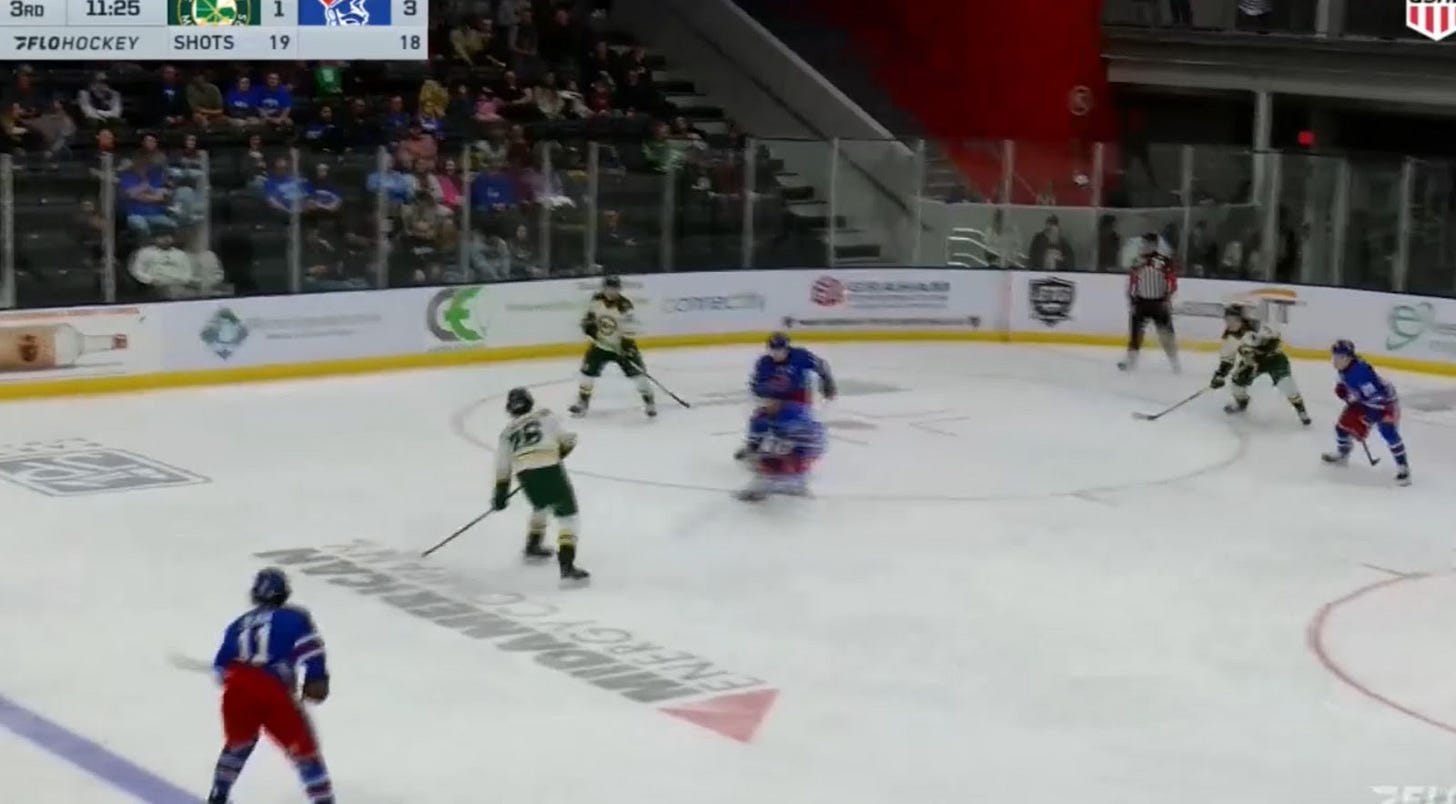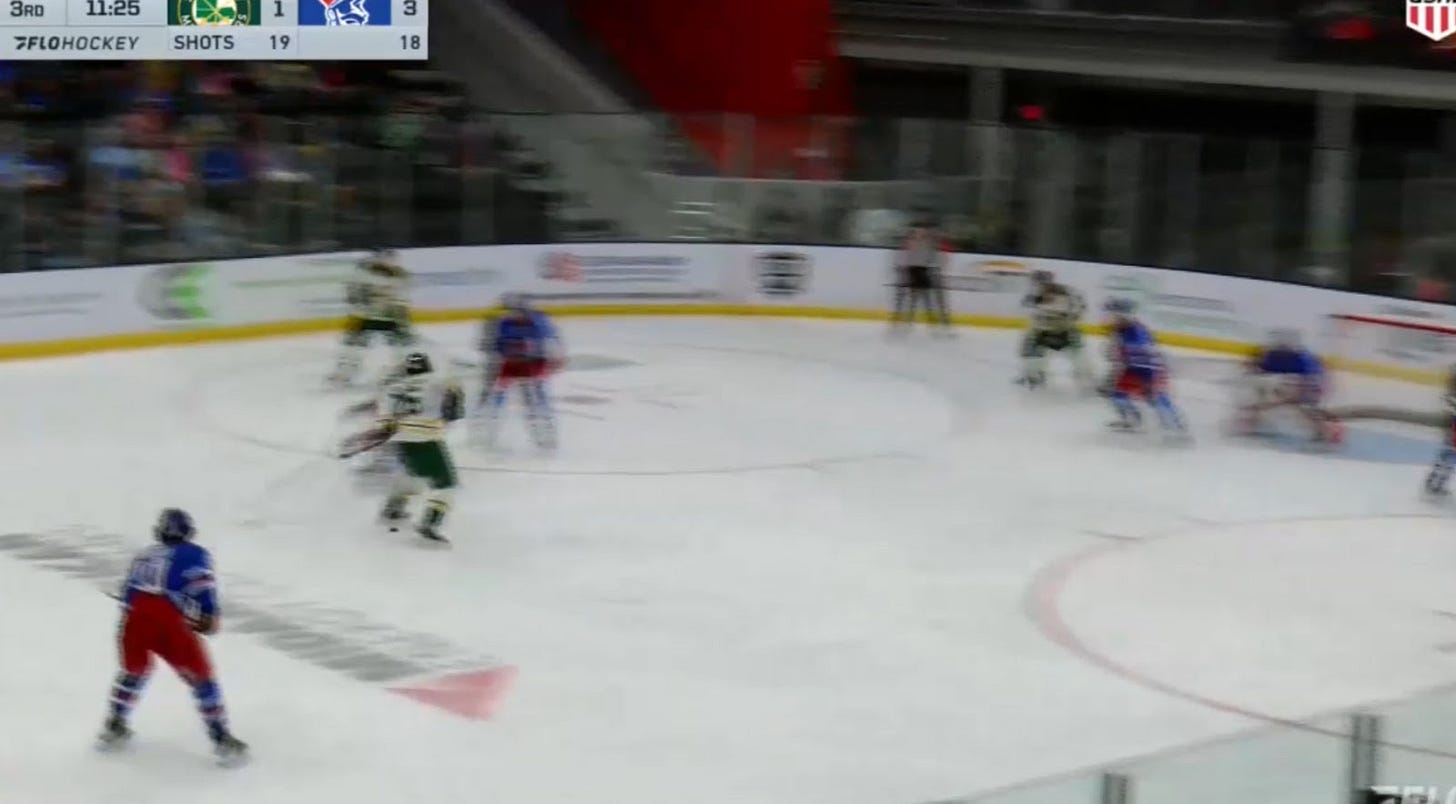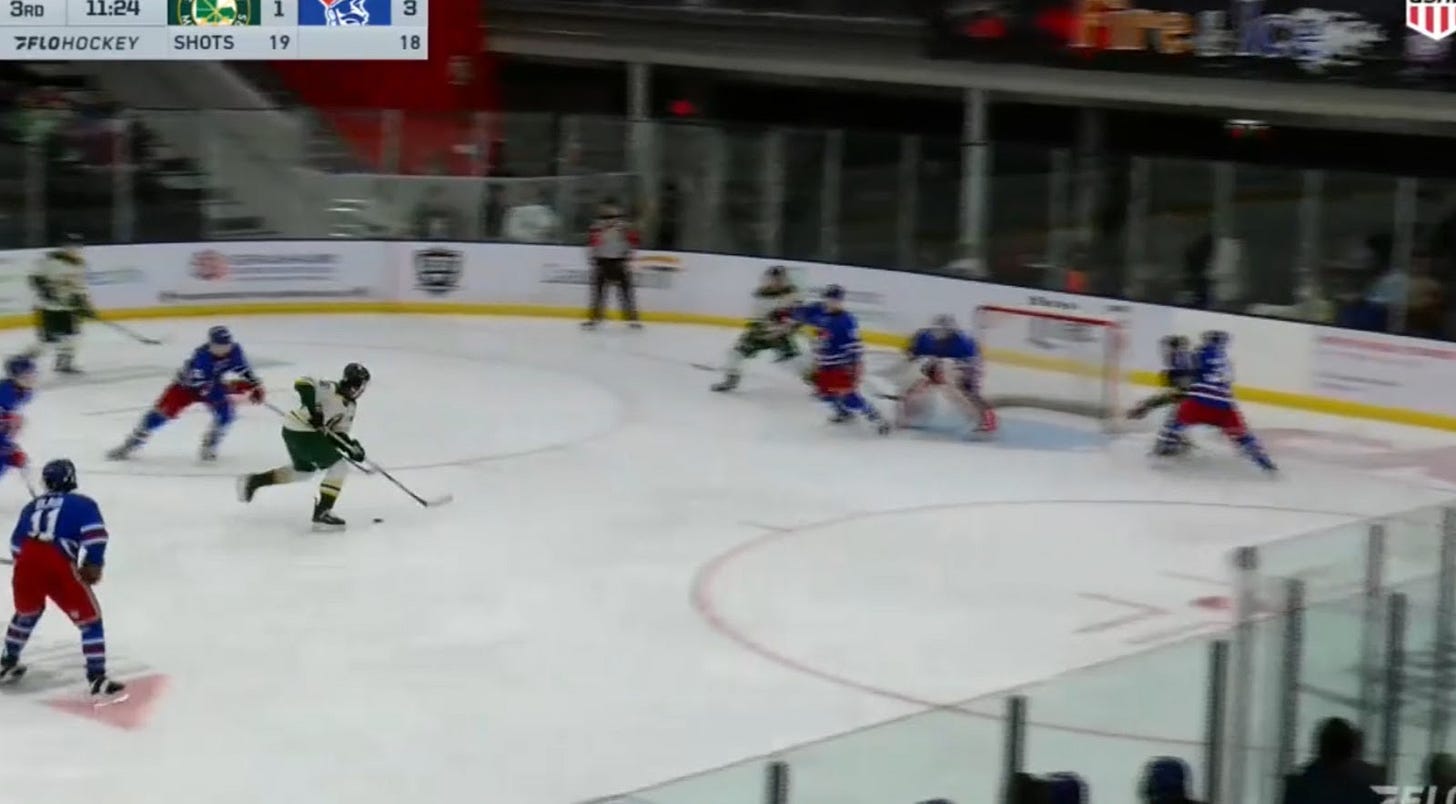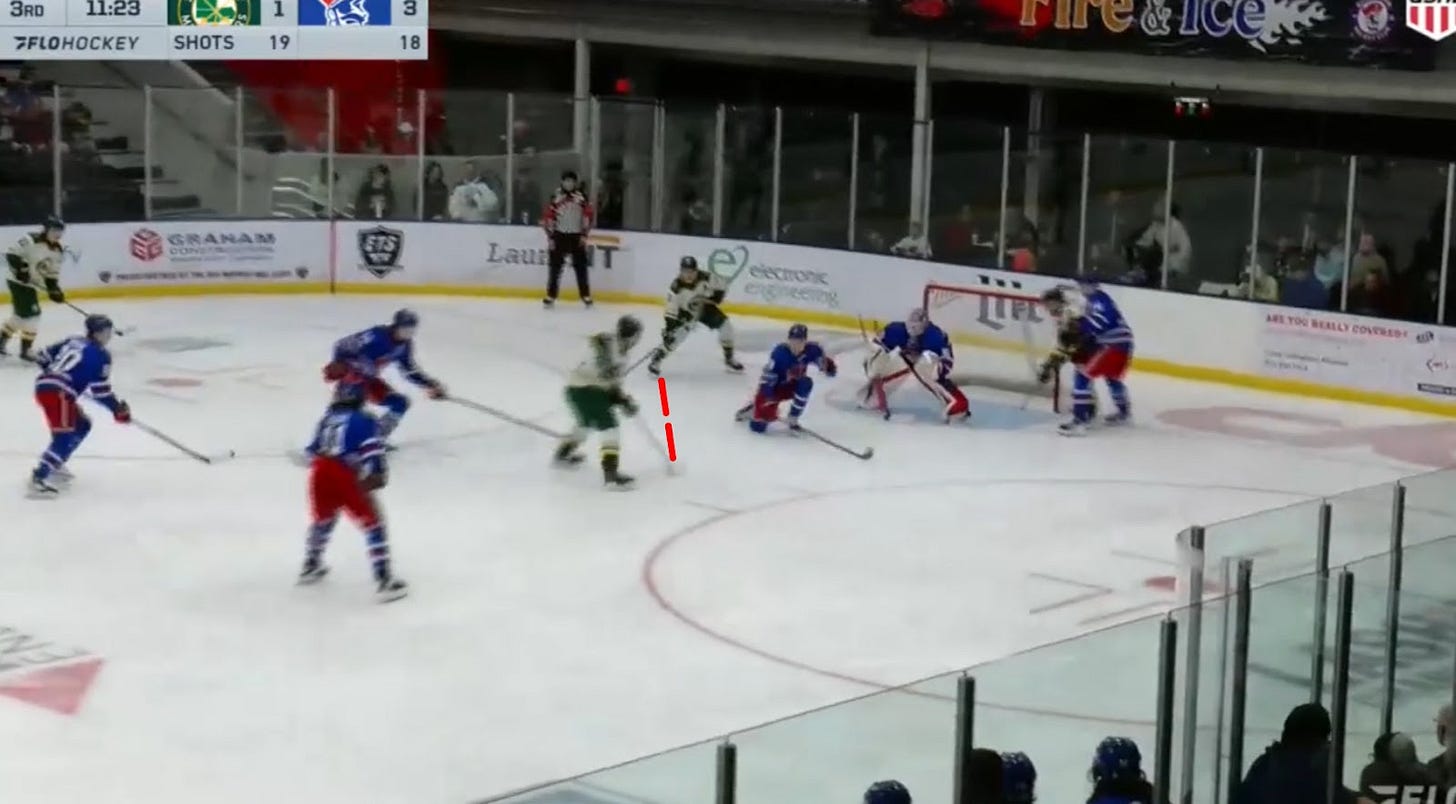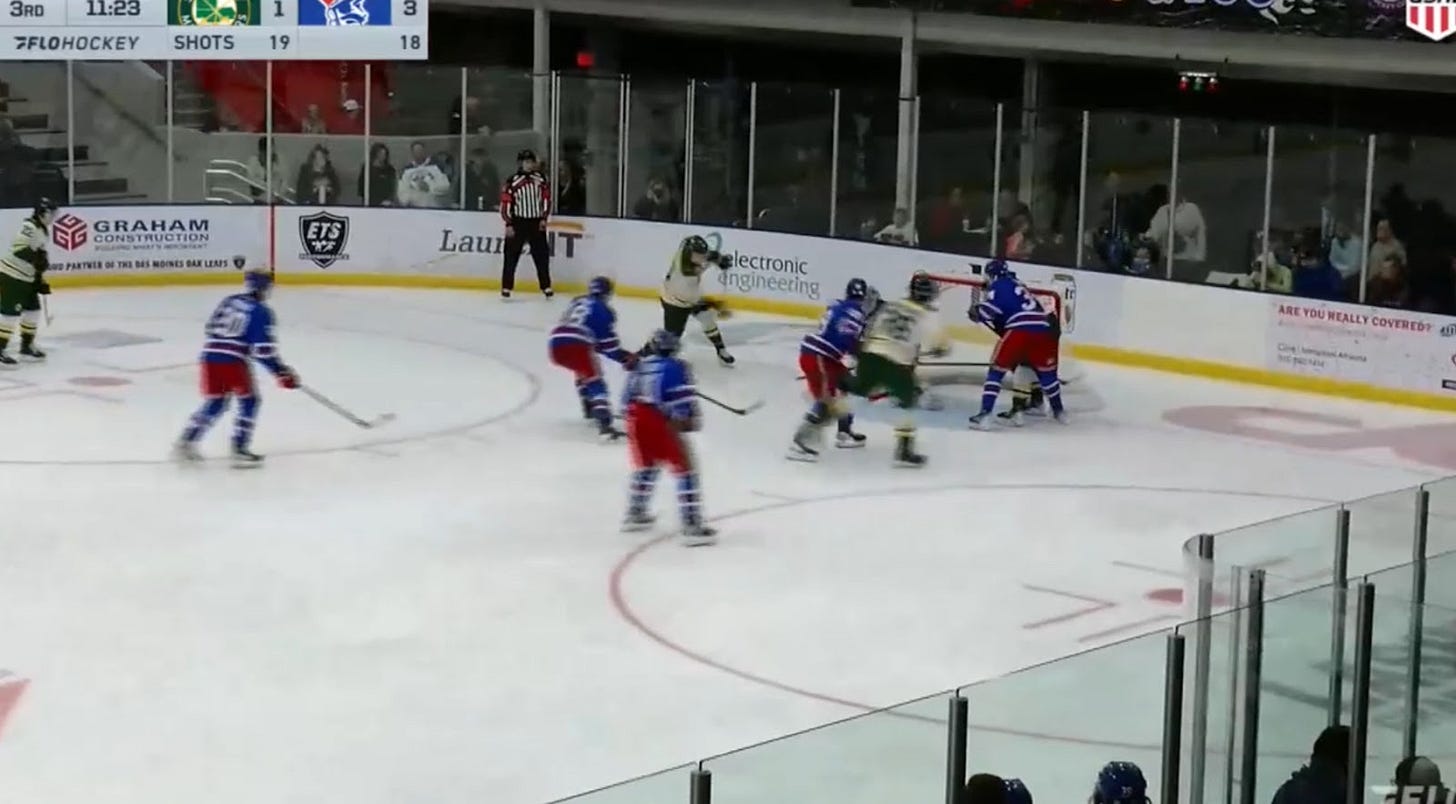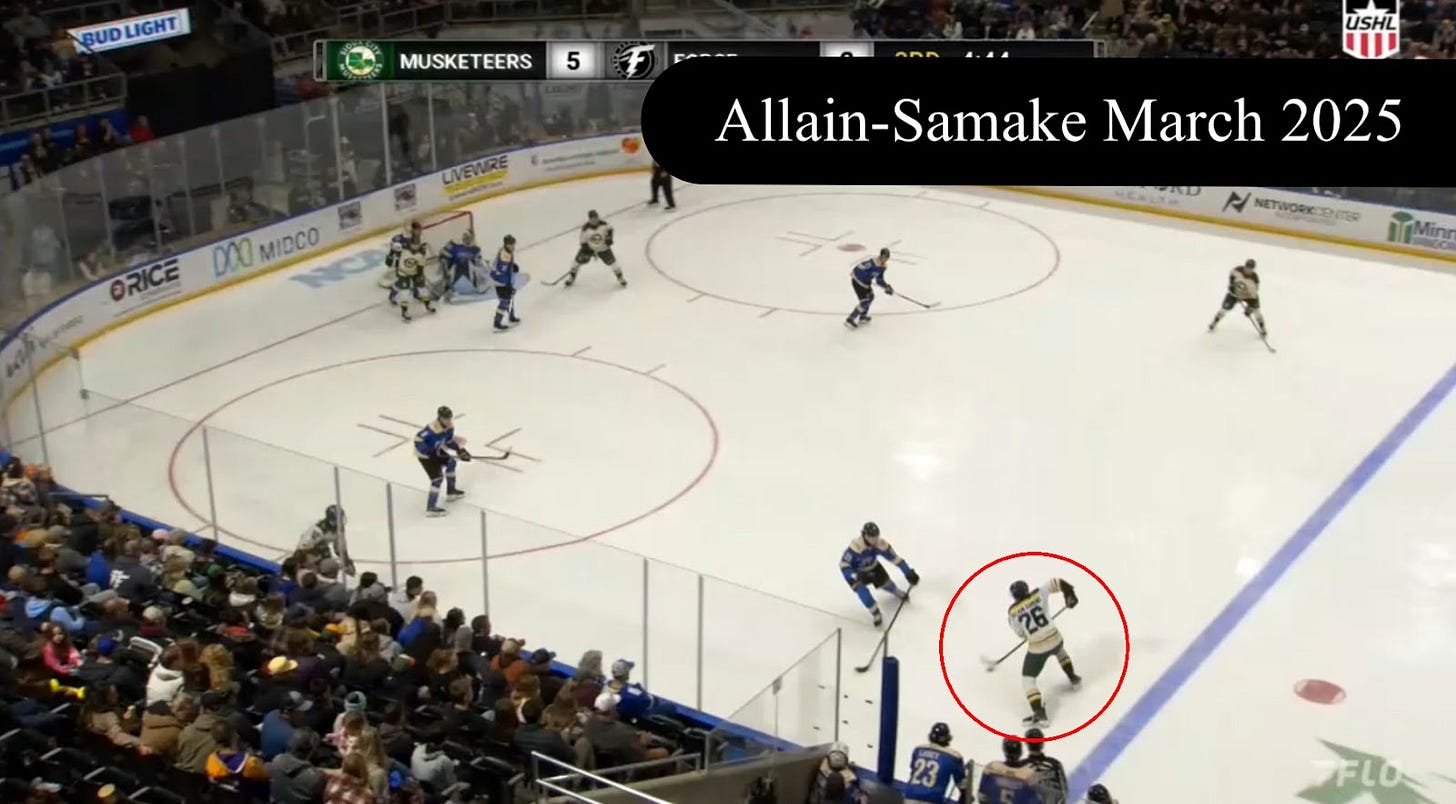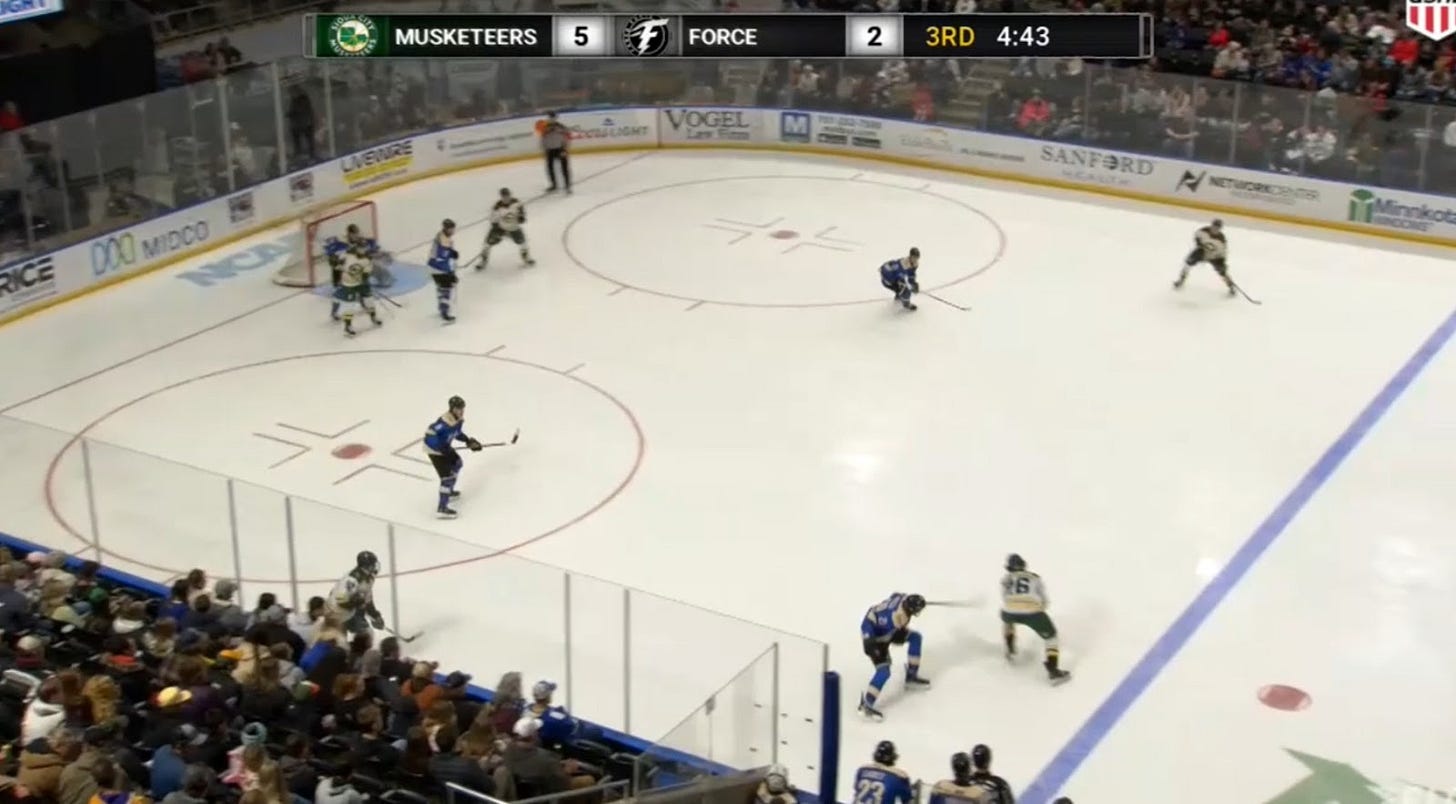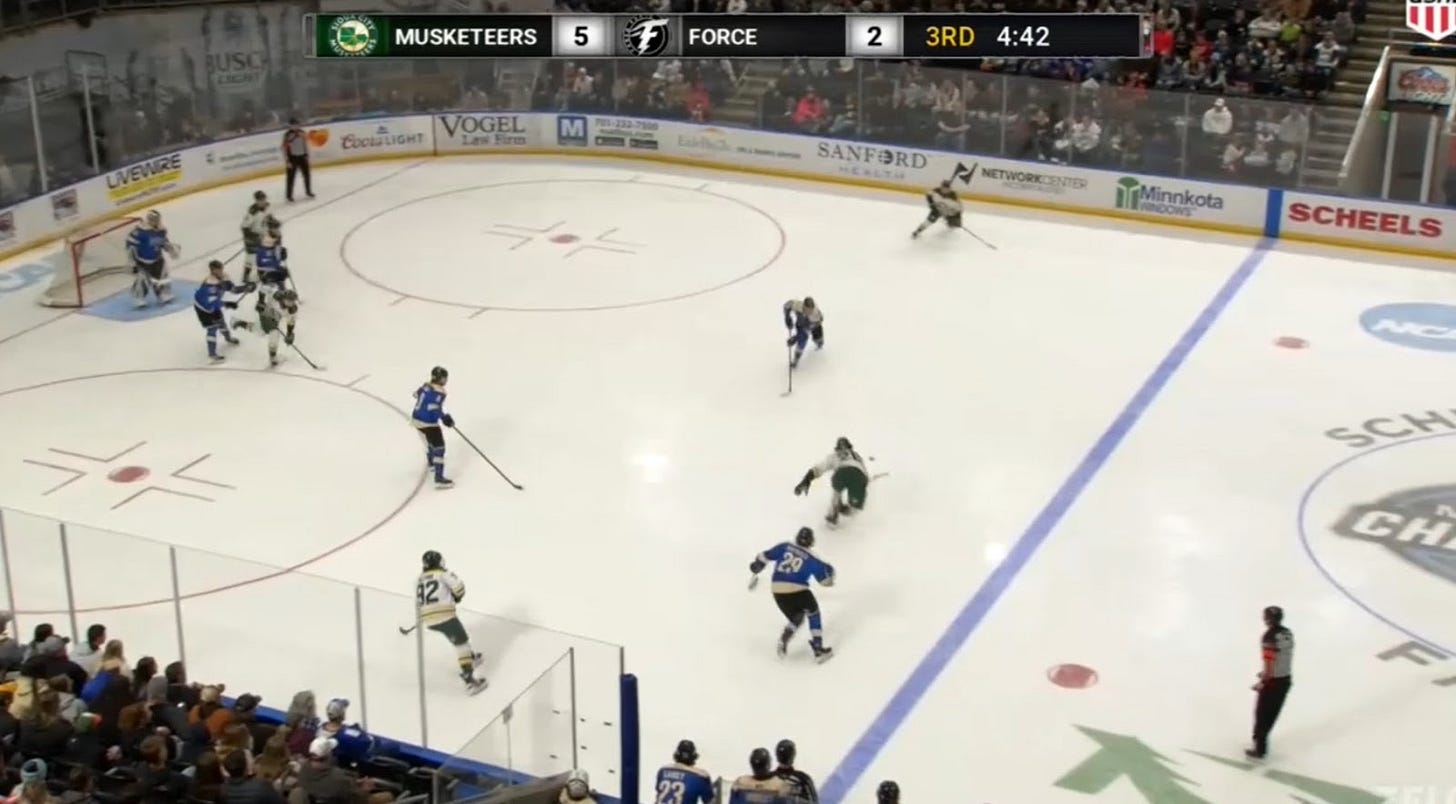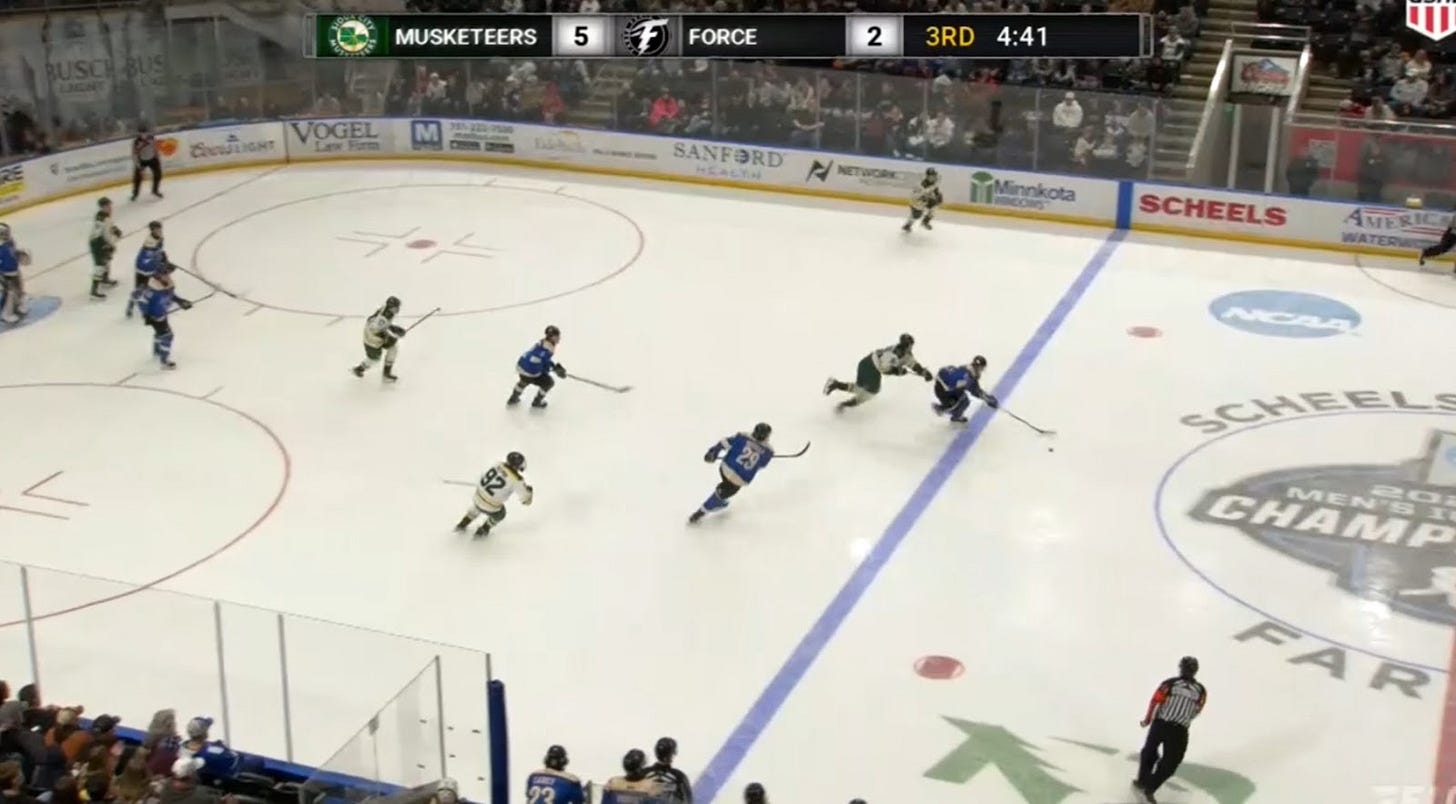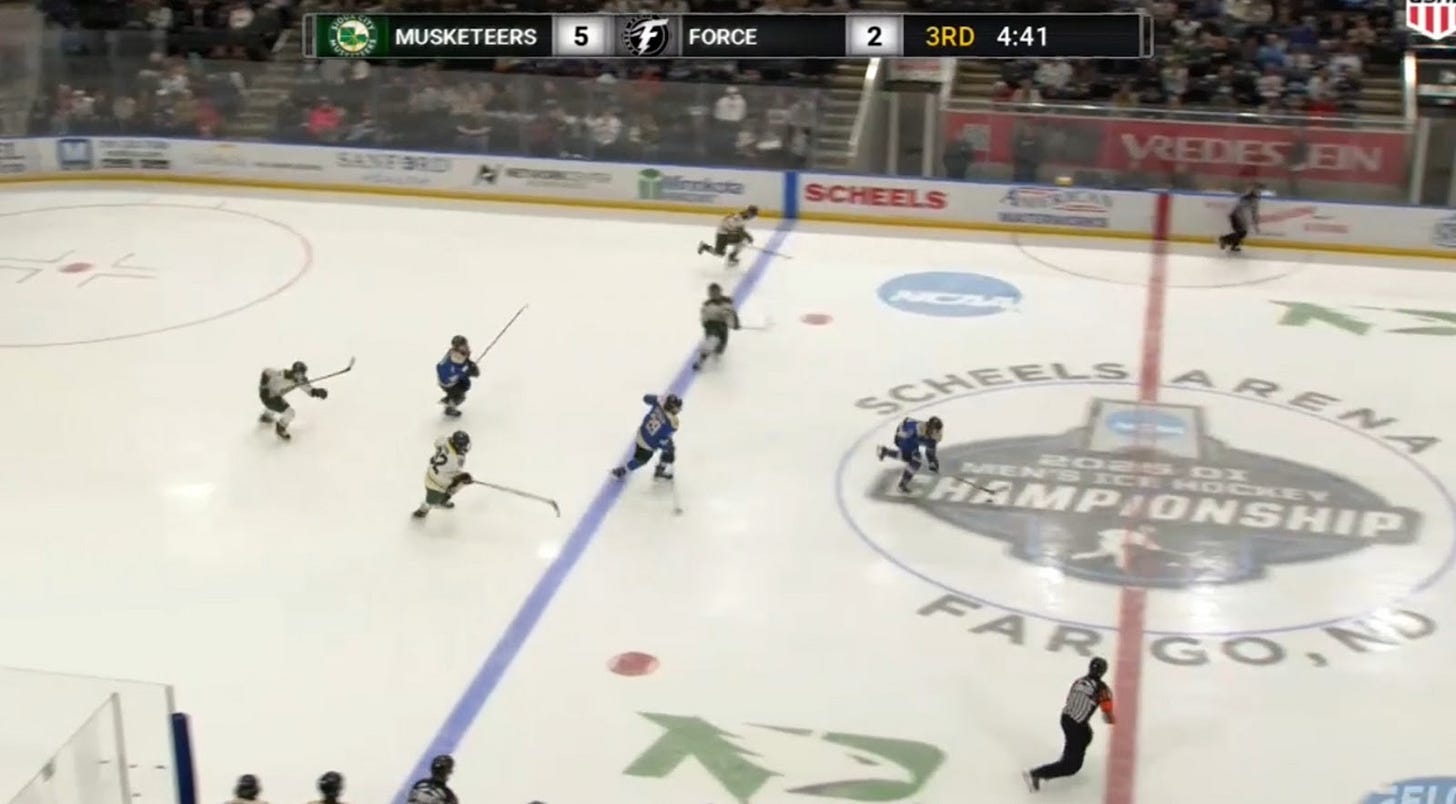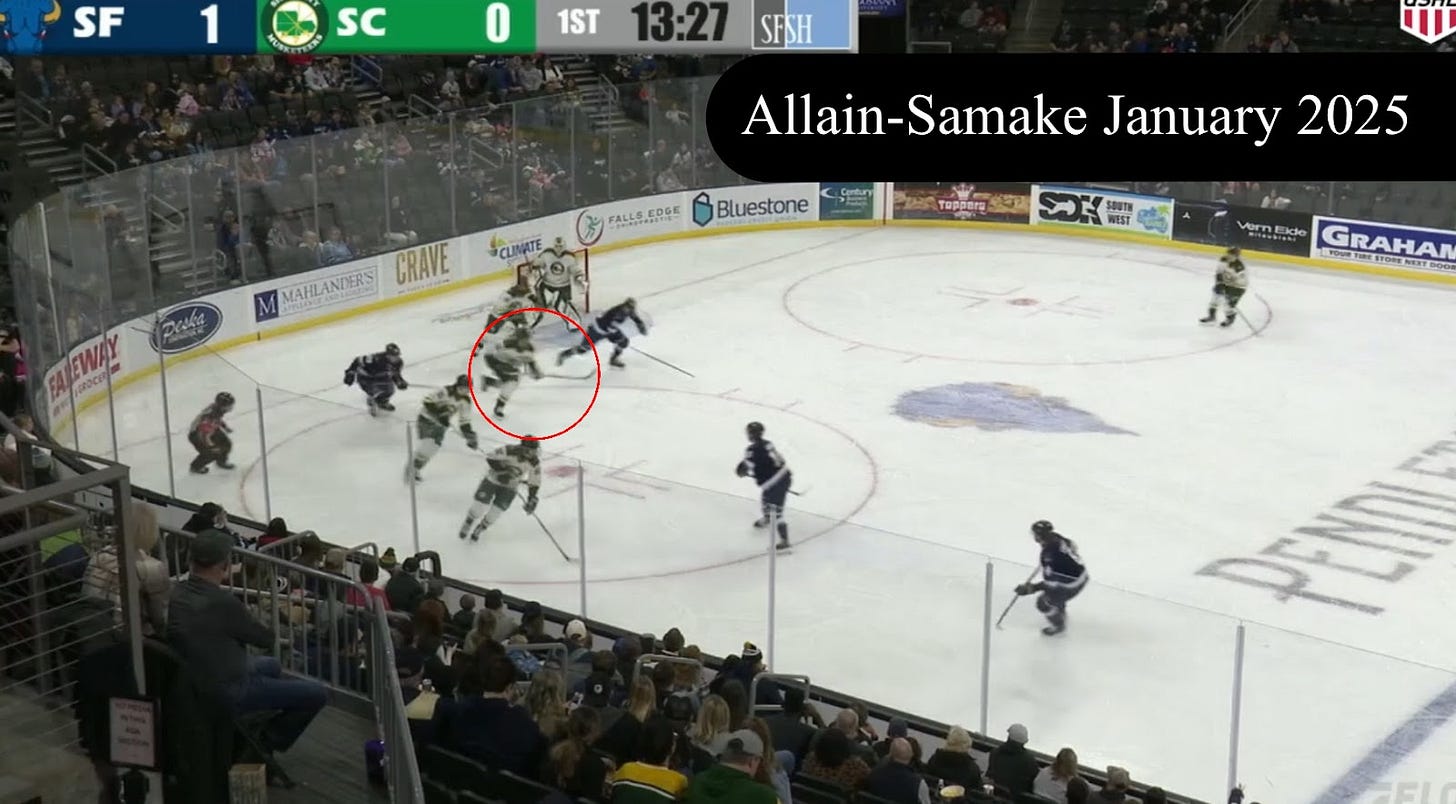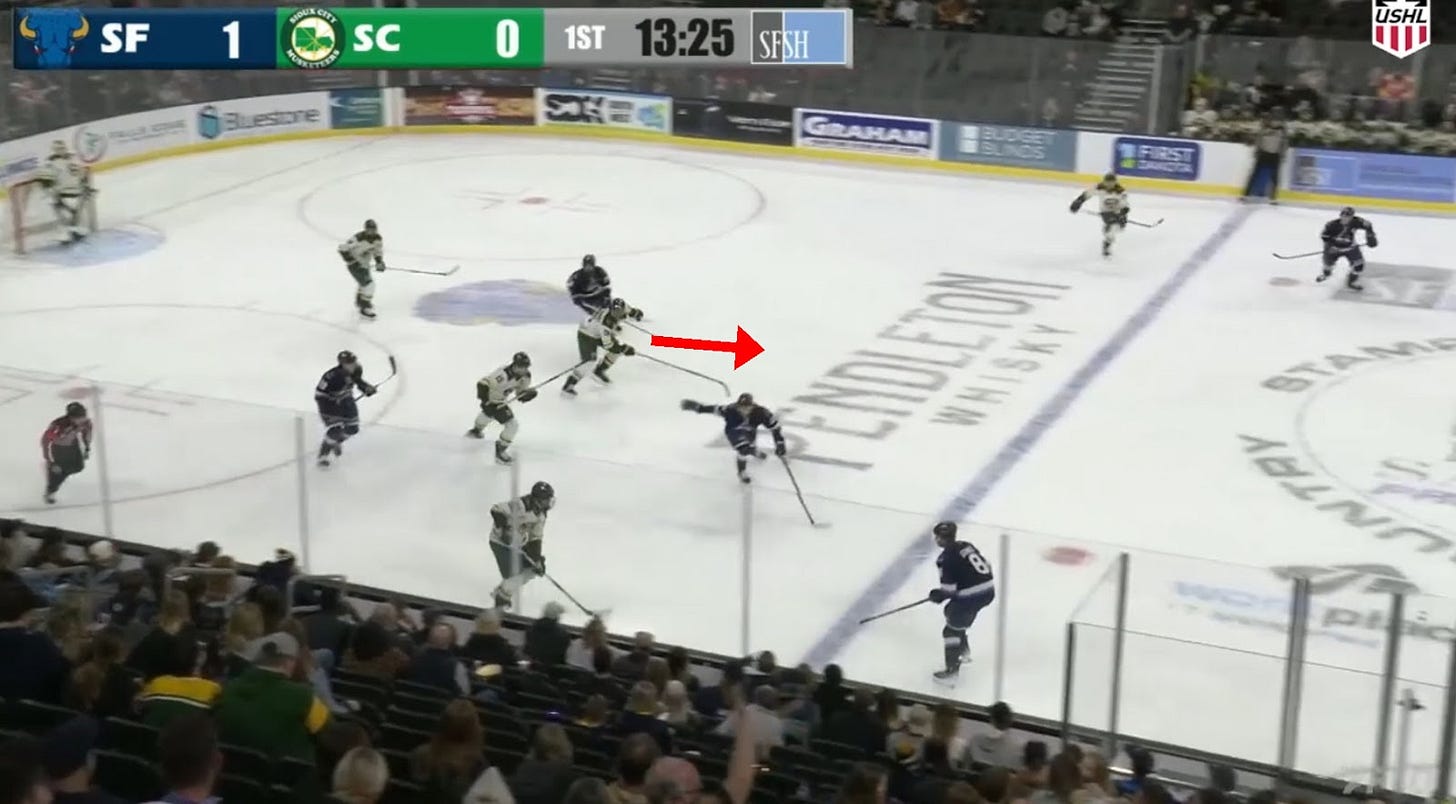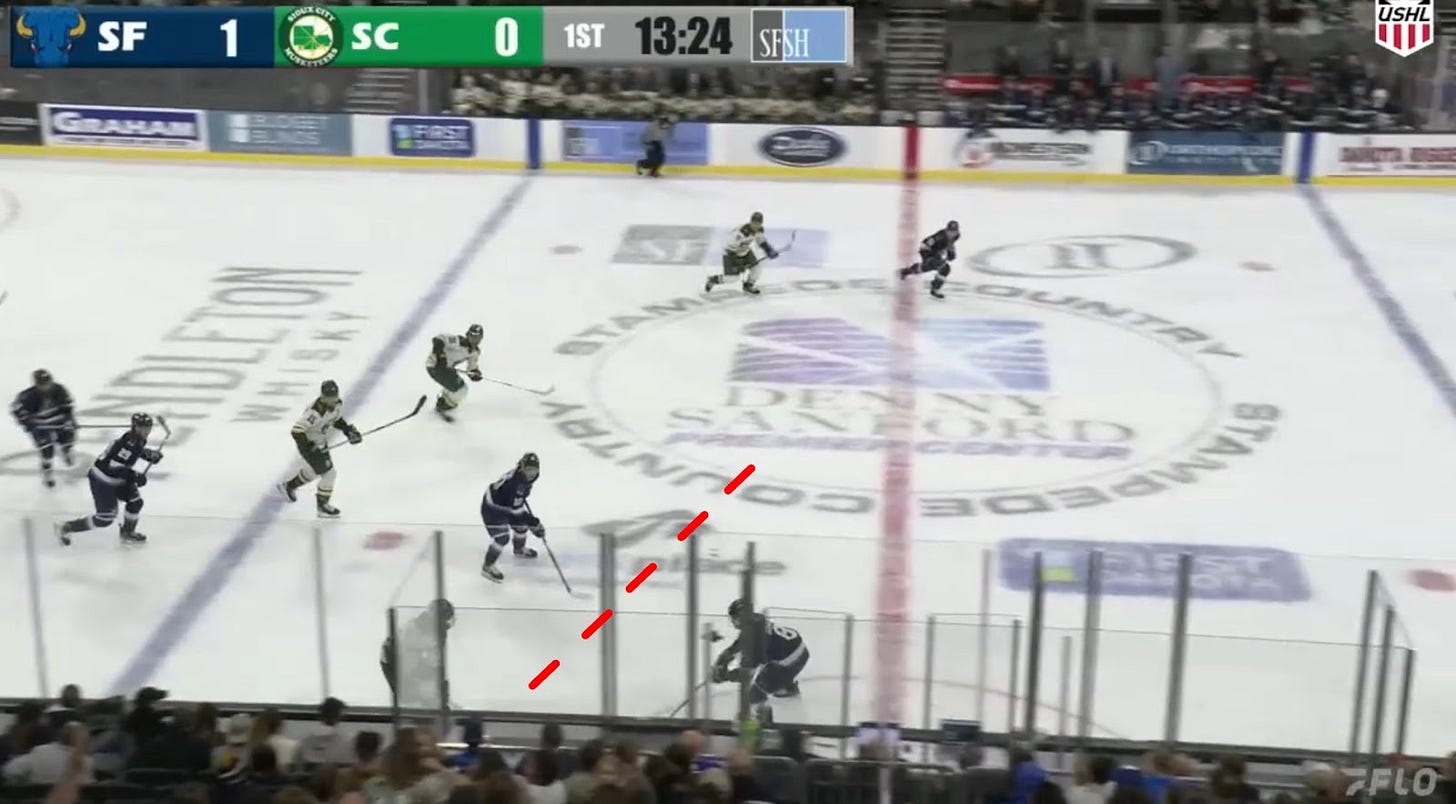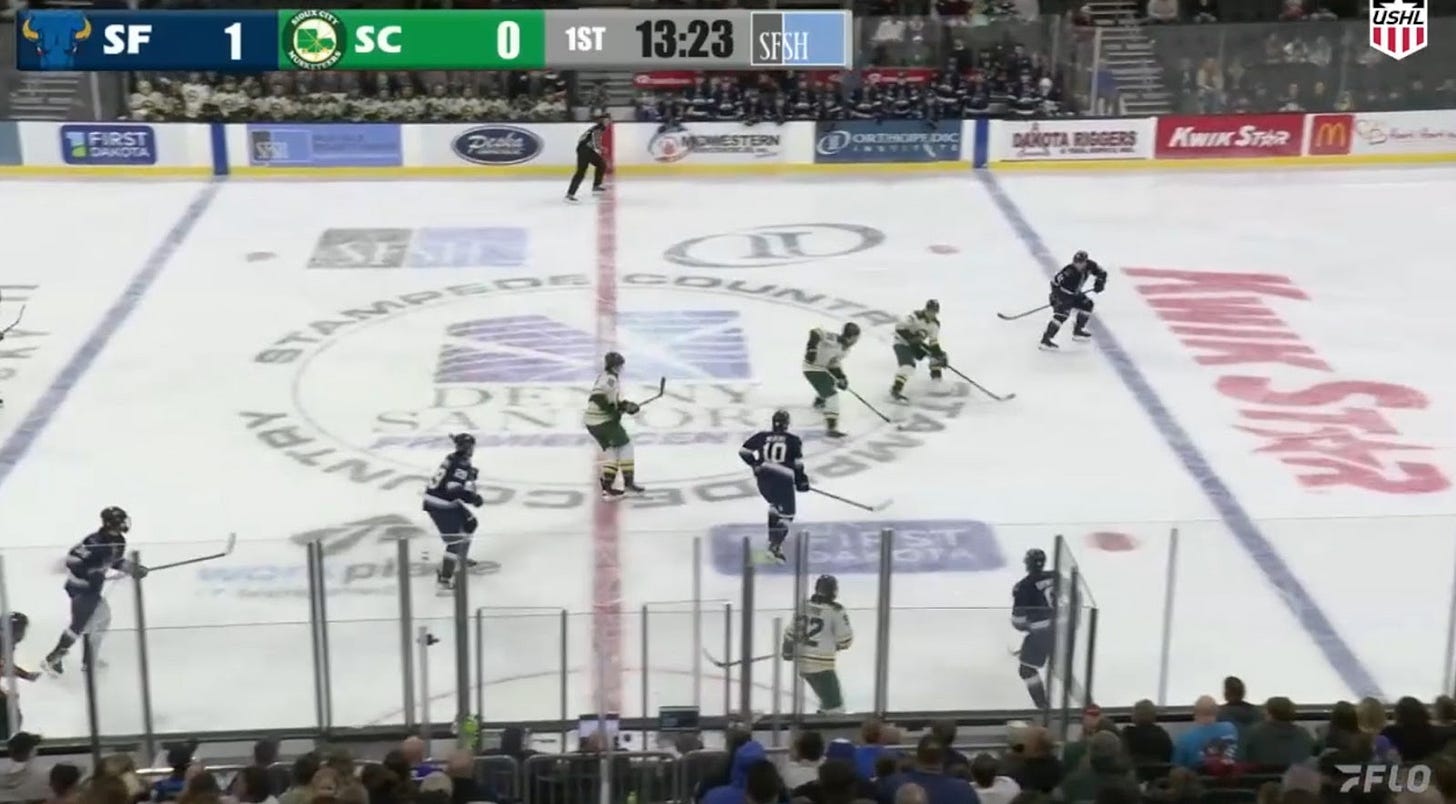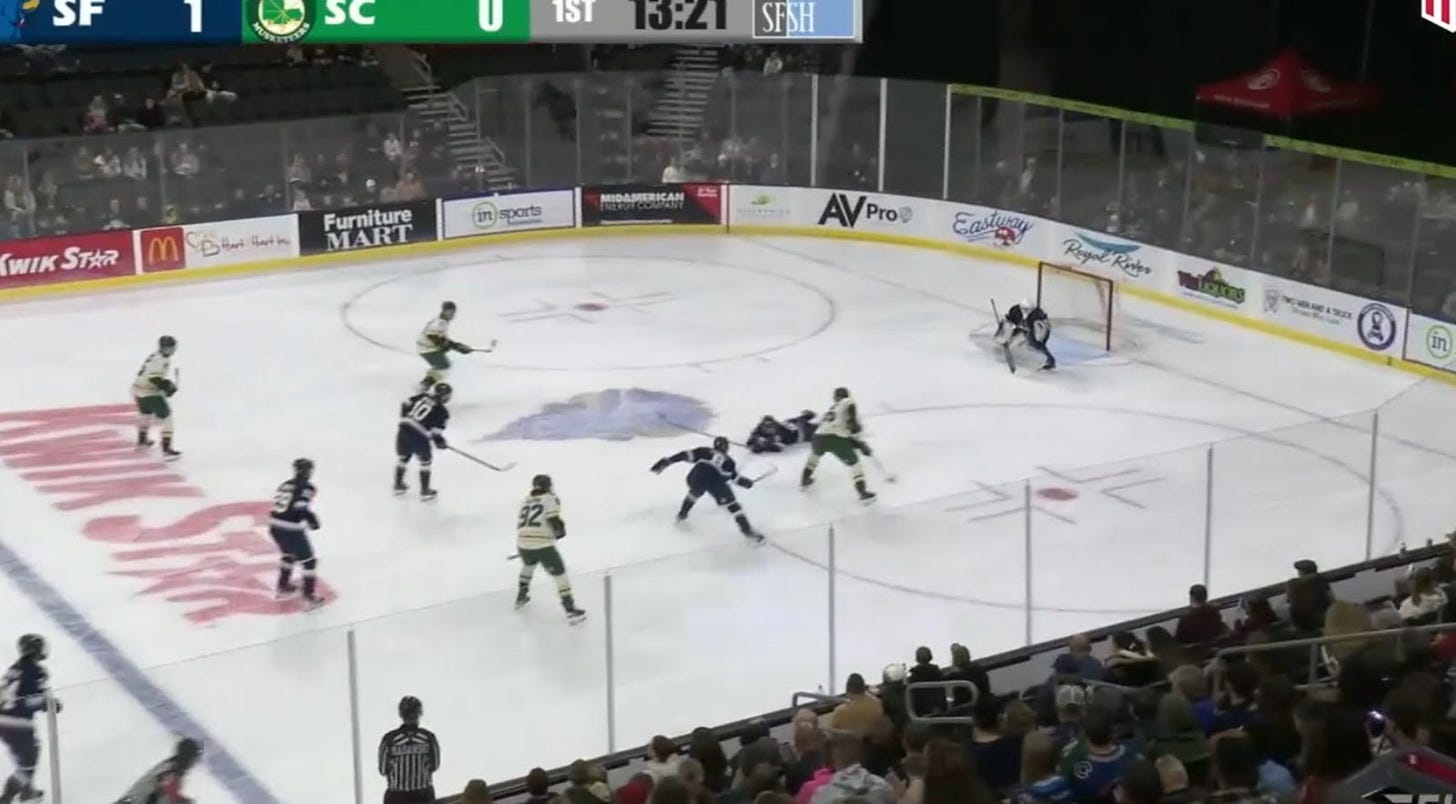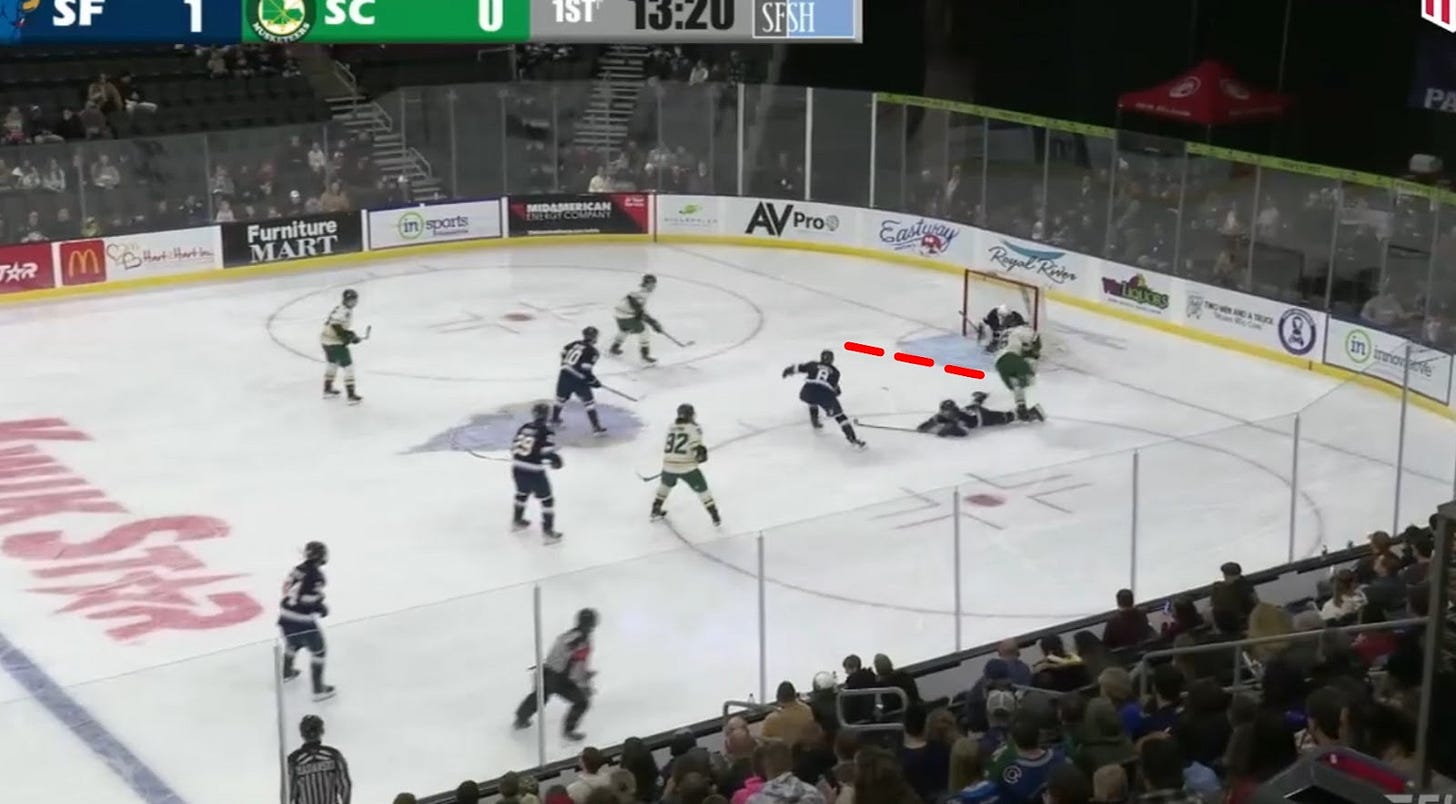Skating:
- Straight Line Skating:
When watching Allain-Samake play, it's clear that one of biggest assets is his skating. Despite it not being perfect, he obviously has higher end speed. His mechanics and habits should make it a translatable asset at higher levels too. His strides are long and he shifts his weight effectively. He bends his knees very well, close to optimally and enough to keep his knees over his toes, allowing his back and shin angle to be close to parallel. His stride recovery is efficient and remains under the midline of his body, with his back leg coming close to full extension, freeing himself to toe push effectively, aiding in a good transfer of momentum. His first three steps could be improved upon. He lacks an explosive 1st 3 steps and takes extra strides to reach top speed compared to elite skaters, but this could be a strength issue. When he is engaged, he shows efficient, translatable mechanics and top end speed, but he occasionally coasts instead of driving feet through full his stride cycles.
Allain-Samake had a top tracked speed in the 86th percentile of all players I have tracked in my 4 year dataset in the 3 USHL games I tracked of him this season. This is made more impressive when taken into consideration that my dataset may be a skewed sample due to my tendency to want to track faster players. Watching Allain-Samake, it’s obvious he is a great skater with a high top speed and translatable mechanics.
Lateral Skating:
Allain-Samaké’s lateral skating stands out as one of his most projectable NHL traits. He has great agility and its one of the first things you notice when you watch him. Much like his straight line skating, his posture and mechanics are good, which give him adaptive four-directional mobility, allowing him to pivot and evade forecheckers. His ability to transition between skating styles, whether surfing backward, executing quick ten-and-twos, or using defensive skating skills to maintain gap control is all impressive. His deep skating stance enhances balance, letting him recover from disruptions and stay engaged in plays even under pressure. It helps him stay wide, keeping him coordinated between his hips and shoulders, helping him move faster and more efficient.
However, his lateral mobility isn’t without flaws. While fluid in open ice, his posture can become wobbly in tight turns, especially when navigating physical contact. His upright stance with the puck at times limits his power generation, causing him to lose battles against stronger opponents despite his agility. This to me is largely because of improper puck placement in his stickhandling. Additionally, though he closes gaps efficiently with lateral bursts, he occasionally over-relies on his edges defensively, leading to overcommitments or getting caught flat-footed when challenged by deceptive forwards. Much like his straight line skating, he also has lapses in effort which effect him despite his foundation. Despite this, Allain-Samaké’s lateral skating is a major strength, but refining his balance through contact and puck placement will determine whether it becomes a true weapon at higher levels. The foundation is undeniable, with improved strength and technique, he could develop into a very mobile defender.
Skills:
Offensive Toolkit
Allain-Samaké’s offensive game screams untapped potential. If he used the tools he has in his toolkit, in a smarter way, and activated through the funnel more, his offensive side could be unleashed. This could be a coaching or confidence thing. Whatever the case, the potential shows itself. When he does activate on cycles he has intelligent puck distribution. His game reflects the evolving role of defensemen in creating offense through controlled movement patterns and smart decision-making rather than relying solely on physical tools or high-volume shooting. The foundation of his offensive impact lies in his advanced passing ability. His statistical profile shows an impressive profile, ranking in the 91st percentile for EV accurate pass% among USHL defenders (minimum 15 games played per Instat) while attempting passes at an 85th percentile rate in the same group. His 88th percentile ranking in EV high-danger passes per 60 indicate that he can drive play toward high danger areas and that these sequences frequently create premium scoring chances rather than simply maintaining possession.
He has the ability to identify and exploit defensive coverage with look offs and subtle movement cues, creating advantages without compromising defensive structure. This awareness translates to tangible offensive results, with rankings in the 76th percentile for EV shot assists per 60 and 60th percentile for EV scoring chances responsible for per 60 among USHL defenders. These metrics reflect his ability to not just participate in offense, but actively improve the quality of his team's opportunities. Transition play represents another strength in his offensive toolkit. His shot selection could be improved based on the mobility he has but he still ranks in the 83rd percentile for expected goals per shot, but he did have limited volume. While his current shot lacks power, he has a foundation of skills to build upon as he develops physically. Areas for continued development include refining his timing on offensive zone activations and improving his ability to handle physical pressure with the puck. His existing combination of deception, mobility and passing vision provides a strong base for these improvements. He has the tools to develop into an effective point producing defenseman at higher levels.
Defensive Potential
As it stands now Allain-Samaké is not a good defender but he does present an intriguing profile for growth. To put it very bluntly, he has the tools to grow into someone who can be trusted in many situations defensively, but he is dumb about how he goes about it now. His skating foundation allows him to maintain good gap control against rushing forwards and execute tight turns when angling opponents toward the boards. Although he does have had some head scratching pinches this season. The defensive aspect of Samaké's skating shows particular promise in his lateral mobility and defensive skating. He can effectively shadow attacking forwards through the neutral zone and into dangerous areas. However, as with many young defensemen, there remains inconsistency in how he applies these tools in game situations. His backward skating mechanics are solid though not elite, and he occasionally struggles with maintaining proper body positioning when forced to pivot quickly. These technical elements form the base upon which his defensive game can continue to develop.
When defending the cycle, Samake gets lost and puck watches too much and it has hurt him at many points during the season. He does show a willingness to compete physically despite not yet having an pro-ready frame, though he does have frequent lapses in focus and coverage that cost his team, His battle frequency ranks in the 89th percentile among USHL defenders (minimum 15 games per Instat), demonstrating commendable engagement, though his current 29th percentile success rate in these battles shows the need for added strength. His aggressive style of on puck defence allows him to disrupt the play at times at times, contributing to his slightly above-average takeaway per 60 numbers (57th percentile among USHL defenders). When examining his defensive zone coverage, Samaké's relative expected goals against (-0.36 xGA/60) suggests he's better than teammates at suppressing high-danger chances, and his raw shot suppression metrics (ranking 6th among 25 team defensemen in corsi against per 60) indicate he doing a good job although he was quite sheltered in his deployment.
Several key areas require focused development for Samaké to reach his potential. He needs to stop puck watching, stay more positionally disciplined, he needs to stop getting lost in coverage and lastly, physical maturation remains crucial. Adding core and lower-body strength would help him win more board battles and establish better net-front clearing presence. He also needs to develop more consistency in applying his technical skills, particularly in maintaining proper gaps and making sound decisions under physical pressure.
Samaké's projection as an NHL defenseman contains both promise and uncertainty. His skating foundation and willingless to engage provide a credible base, while his September birthday makes him one of the youngest draft eligibles, suggesting additional natural development is likely. If he can address his physical and focus challenges he can become a capable defender at the next level. However, his development path carries more variables than typical prospects due to the refinements needed in several key areas of his defensive game.
Stickhandling
Allain-Samaké demonstrates has both creativity and inconsistency when it comes to his stickhandling. The foundation of Samaké's stickhandling shows several positive indicators. His willingness to engage defenders ranks in the 94th percentile for dekes attempted per 60 minutes among USHL defenders (minimum 15 games played per Instat) reflecting confidence in his ability to beat opponents. When successful, he displays proper technique, maintaining compact hand movements and using body positioning to protect the puck. His ability to spin away from contact while retaining possession is noteworthy in his viewings.
However, Samaké's current 52.3% deke success rate places him in just the 11th percentile league-wide among defenders, revealing significant inconsistency. The gaps in his execution stem from several identifiable factors. His puck positioning occasionally falters at speed and in traffic, leading to turnovers when attempting more complex moves. While his edgework is good, there are instances where his weight transfer doesn't properly sync with puck movements, causing failed dekes or bobbled receptions. These technical inconsistencies are compounded by decision-making that sometimes favors high-risk attempts over simpler plays, particularly evident when forcing passes into covered lanes.
Physical development represents another key factor. Samaké's current frame limits his ability to finish plays after beating the initial defender. Attempting to do a lot with the puck when you aren’t the strongest and you have players trying to rip the puck from you is not a recipe for success. His tendency to skate himself into turnovers, forces unnecessary rushed decisions that lead inevitably lead to giveaways. The cognitive aspects of Samaké's puck handling show promise. He shown defensive manipulation skills are high end for his age. There are sequences where he uses head fakes and shoulder dips to create passing lanes reveal, which reveal strong spatial awareness. These processing skills suggest his stickhandling could become more effective with improved strength and refined technique.
Better puck placement would help stabilize his puck control in traffic. Improved decision-making could reduce unnecessary risks by better reading defensive pressure. He also needs to stop trying risky moves in dangerous areas. He’s had costly giveaways at points this season trying to take on opponents as last man back or in high danger areas in his own zone. I am hopeful this improves with mental maturation. Physical maturation will allow him to better protect the puck and maintain balance through contact. His projection hinges on addressing these areas.
Transition Offence
Anthony-Allain Samaké's transition game is built on his skating. He really leverages this in transition. His ability to exit the defensive zone with control and activate into the offensive rush separates him from most junior aged defensemen. The foundation, again, lies in his mobility and four-directional agility which allow him to evade forecheckers, pivot under pressure and join the rush with separation from backcheckers. These tools translate to strong transition numbers: 78th percentile in EV controlled exit percentage, 76th percentile in EV exits via carry, and 74th percentile in EV controlled entries per 60 among USHL defenders (Minimum 15 games per Instat).
His puck movement is very solid. He manipulates defenders through delays, feints and look-offs to create passing lanes. The 82nd percentile in EV controlled entries via pass demonstrates his ability to create valuable transition plays without being directly involved as the puck carrier. He consistently identifies weak-side activation opportunities, often joining as a late option when opponents fixate on the primary rush. This spatial intelligence extends to the offensive zone, where he prioritizes slot passes over perimeter shots. What I’ve seen him do way too often however, is enter the zone, look off options, cut to the outside and get closed out easily. This is something that again, I hope improves with mental maturation. His current lack of a real shooting threat also affects his ability to take opportunities for himself best on the rush.
Samake ranks in the 93rd percentile in EV dump-in entries per 60. To me this is because of pressure from the coaches and the system that Sioux play as well as Samake skating himself into trouble on the entry and being forced to dump the puck in where he otherwise wouldn’t have. Whatever the case, the tools exist for him to become a dominant transition defenseman, both in junior and with development at the higher levels as well. The mobility and puck skills are clear to see and while the physical maturation and decision-making needs work there are also clear developmental pathways.
Perception:
Tactical Recognitions
The Sioux City Musketeers operated as a aggressive, forecheck-focused team in the 2024-25 season, employing an approach designed to create high-danger chances through sustained offensive zone pressure. They led the USHL in offensive zone cycles per game, emphasizing puck retrieval and down-low play rather than rapid transition offense. This system, while effective for the team overall, did not necessarily align with Anthony-Allain Samaké’s strengths as a mobile, but physcially weaker, transition-oriented defenseman. The Musketeers finished with a 31-23-8 record and the league’s best penalty kill, but their stylistic preferences limited Samaké’s ability to fully utilize his skill set. Samaké averaged 15:54 of ice time per game, primarily in a third-pairing role, and rotated through five different defensive partners. His most frequent pairing was with Drake Murray, but the lack of consistent deployment made it difficult for him to establish chemistry. I should also mention he fell out of favour with the coaching staff losing ice time as the season went on. This could be for a multitude of reasons including his lapses in defensive focus and coverage against the cycle, his inability to deal with physical pressure or maybe some sort of undisclosed injury, although that is purely speculative. On special teams, his usage was limited, he saw 1:28 per game on the second power-play unit, though Sioux City’s preference for a five-forward top unit restricted his opportunities. He also logged 1:00 per game on the penalty kill in a support role, though the team’s success in that area meant there was little reason to expand his responsibilities.
The Musketeers’ system relied heavily on dump-and-chase hockey, ranking last in the USHL in counterattack chances per game and dead last in efficiency, with only 39% of those chances resulting in shots. This approach minimized Samaké’s ability to impact the game through controlled breakouts and neutral zone activation, two of his most translatable skills. Sioux City’s emphasis on cycling and forechecking over quick-strike offense meant he was often relegated to a more conservative role.
Despite the system constraints, Samaké still demonstrated flashes of high-end potential. His ability to manipulate defenders, create scoring chances through high danger passes and carry the puck up ice often stood out in sequences where he was given room to operate. When watching their were point you could see him lead a rush, cut across the defensive line, and slip a pass around a defender’s feet to create a point-blank scoring chance. These moments, however, were infrequent in a structure that prioritized grinding offensive zone time over transitional creativity. Looking ahead, Samaké’s move to the University of Connecticut should provide a better developmental environment. Sioux City’s structure, while effective for team success, did not optimize his individual skill set.
Speed Perception
Anthony Allain-Samaké presents an interesting case study in how young defensemen process the game. His obviously has offensive instincts which stand out, but his ability to read plays shows both promise and inconsistency. Allain-Samaké demonstrates good awareness in certain situations. He regularly scans the ice before retrieving pucks, which helps him identify passing options under pressure. He shows patience with the puck (sometimes too much), often waiting for plays to develop rather than forcing low-percentage chances. Examples include his use of delays and fakes to create passing lanes, like when he drew a defender in before making a no-look pass to a teammate. These plays suggest he understands how to control the pace of the game. However, his decision-making breaks down when facing sustained pressure. He sometimes makes rushed passes or loses track of coverage, leading to turnovers. Defensively, he tends to give up the blue line too easily rather than challenging entries. These issues point to a player still learning to process the game at higher speeds. Overall though, his scanning habits are a strength. There are moments where his processing speed looks very fast, however, his reads aren’t yet consistent. His development at the University of Connecticut will be key. If he can improve his consistency under pressure and become more assertive defensively, he has the tools to develop into an NHL defenseman. His skating and offensive instincts provide a solid foundation, but he needs to refine his reads and reactions.
Anthony Allain-Samaké is one of youngest players in the 2025 NHL Draft (September 10th birthday, he misses the 2026 cutoff by days), his developmental runway is exceptionally long. Right now, his lean frame leaves him vulnerable to being overpowered along the boards and in net-front battles. He lacks the strength and or will to win inside positioning, and his balance through contact can waver. However, this is less of a concern given his age, he has years of physical and mental maturation ahead. If he adds strength, his game could take a massive leap. Allain-Samaké is far from a finished product. His defensive-zone habits need refinement, he can be too passive defending the rush, and his gap control fluctuates. His shot lacks power, and his puck skills, while flashy, aren’t yet refined enough to consistently beat pro-level pressure. But the tools are undeniable: elite mobility, offensive instincts, and glimpses of high-level processing.
Given his rawness, Allain-Samaké is best viewed as a high potential option from the third-round onwards. He would be one of my top late round swings this year. If he develops as hoped, he could become a transition-driving defenseman with middle-pair upside. If his physical development stalls, and his lapses in focus continue, he may top out as a college defender or toolsy pro defender somewhere in Europe. For a team willing to be patient (he needs all those years in college) he’s exactly the kind of high-reward prospect worth betting on in the mid-to-late rounds. The next few years at UConn will be critical. If he tightens his decision-making, adds strength, and polishes his defensive details, Allain-Samaké could emerge as one of the steals of this draft.
Finlay Sherratt
June 2025
613-879-4316




